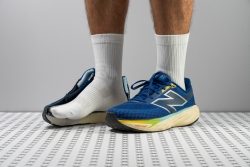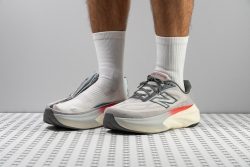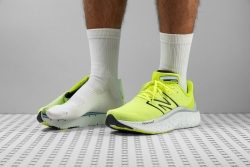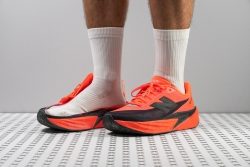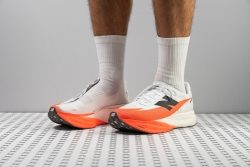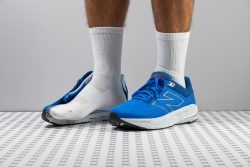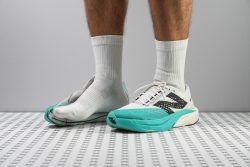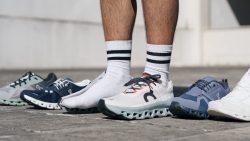7 Best New Balance Running Shoes in 2025
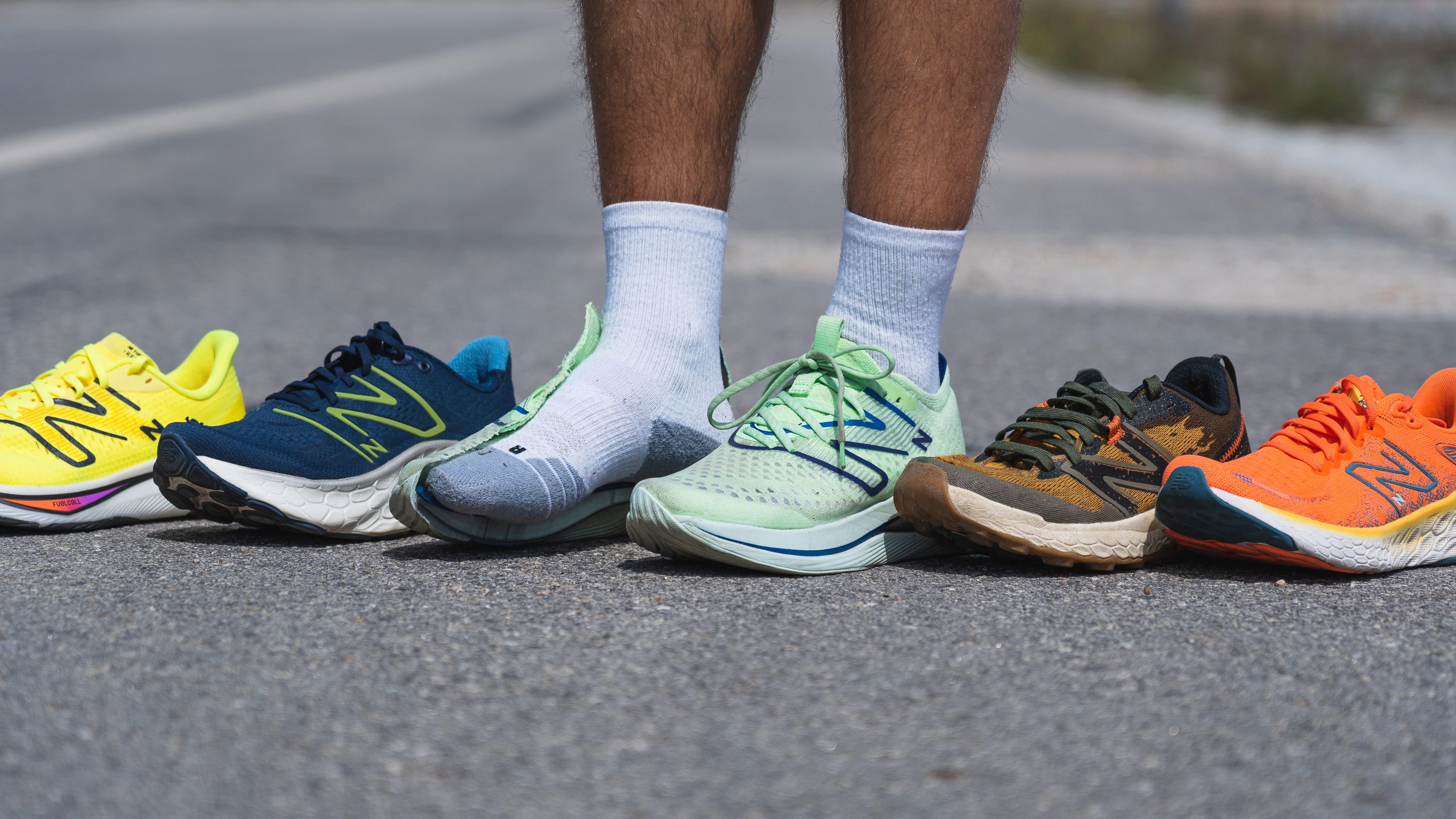
We buy shoes ourselves. We earn commissions when you buy through us, at no extra cost. Why trust us
New Balance has become a go-to brand not only for stylish lifestyle footwear but running shoes as well.
Given how easy it is to get lost in all those FreshFoams and FuelCells, we are here to narrow down your choices. We have tested all these road and trail running shoes from New Balance to select the best options in various categories.
Whether you’re after a well-cushioned trainer for daily runs, a budget-friendly all-arounder, or a speedy shoe for personal bests, we’ve got them all covered.
See our top picks in various categories!
How we test New Balance running shoes
With over 150 New Balance running shoes to choose from, we present you the crème de la crème.
If you are interested to know how we do it:
- We literally put every shoe through the wringer, cutting it open and measuring over 30 different parameters on shock absorption, energy return, softness, flexibility, durability, etc. We do all this testing in our esteemed and independent shoe-testing lab
- As a team of dedicated runners, we log miles in each pair before sharing our experience.
- We also keep our scores as objective as possible. So, all New Balance shoes are purchased with our own funds, helping to eliminate brand loyalty and bias.
Best New Balance running shoes overall
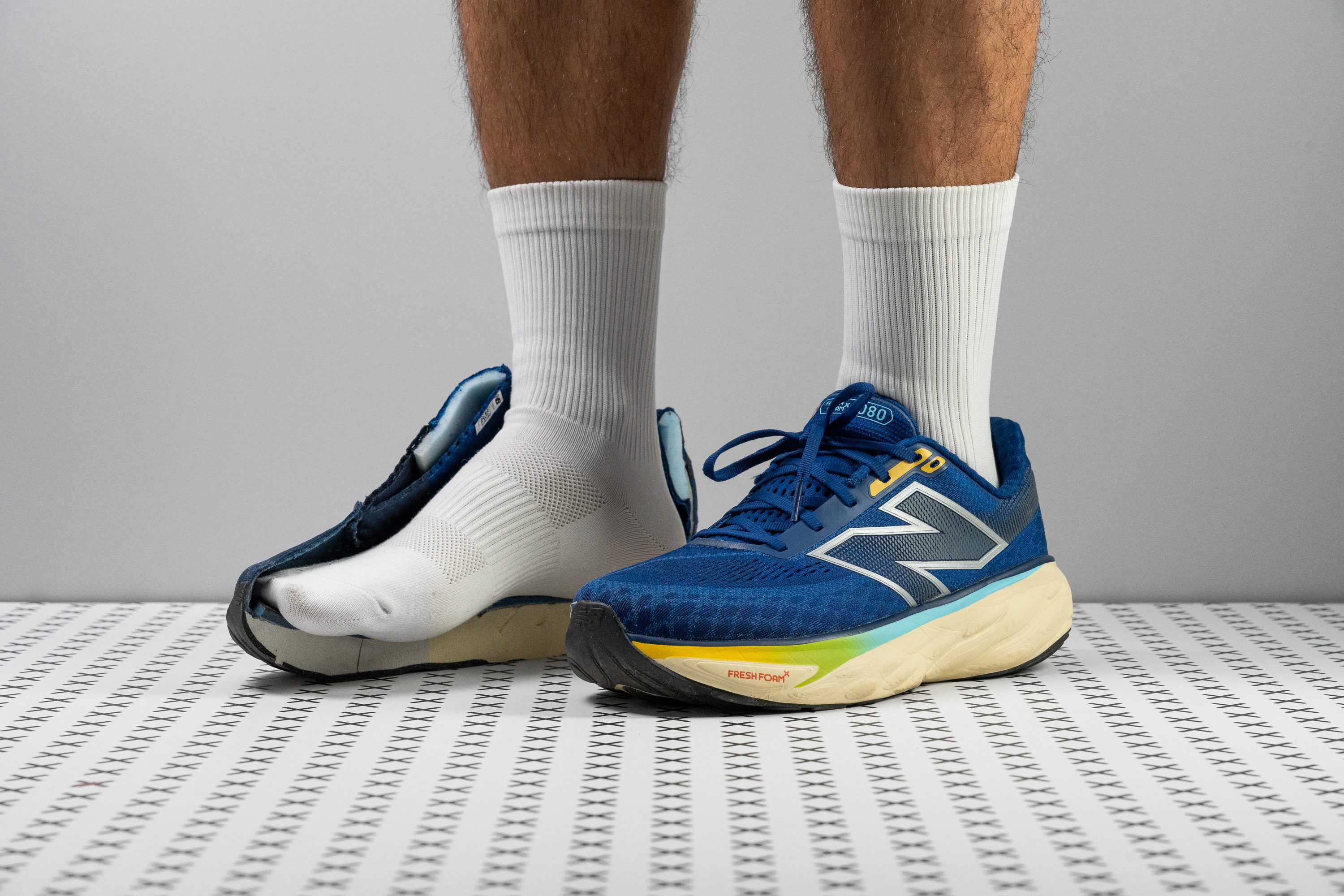


















































What makes it the best?
After miles of sweaty runs and hours of lab tests, the New Balance Fresh Foam X 1080 v14 is our top running shoe in the New Balance roster. It offers out-of-this-world comfort with its plush midsole, flexible build, and unrestricted ventilation—making it a good place to be in for long hours.
The lab numbers had the proof, but our feet lived to tell the tale. The foam feels so delightful, oozing heavenly levels of comfort. Our durometer confirms a low measurement of 11.9 HA—43.3% softer than its counterparts. The stacked 37.0/32.8 mm platform delivers impact absorption and a pain-free experience in our daily runs.
The shoe’s flexible build boosts comfort, allowing us to move naturally without much resistance. Our bend test confirms it’s 6.4% more adaptive than average, a pleasant surprise considering its thick foam.
The knitted upper is a step above the rest. It seamlessly blends padding and ventilation—free from any rubbing, blisters, and sweat while racking up those miles. Our lab breathability test confirms the perforated upper gets a remarkable 4/5 score.
Because the foam is still EVA-based, it lacks the spring and energy return to conquer speedier runs. Those who crave excitement should find more responsive trainers.
Pros
- Amazing step-in feel
- Excellent durability
- Cloud-soft midsole
- Ideal for forefoot and midfoot strikers
- Perfect for recovery runs
- Airy upper
- Fairly priced for a premium daily trainer
- Stability improvements
Cons
- Noticeable weight increase
- Tapered toebox limits toe splay
- Midsole could be too soft for some
- Lacks energy return
New Balance running shoes with the best shock absorption
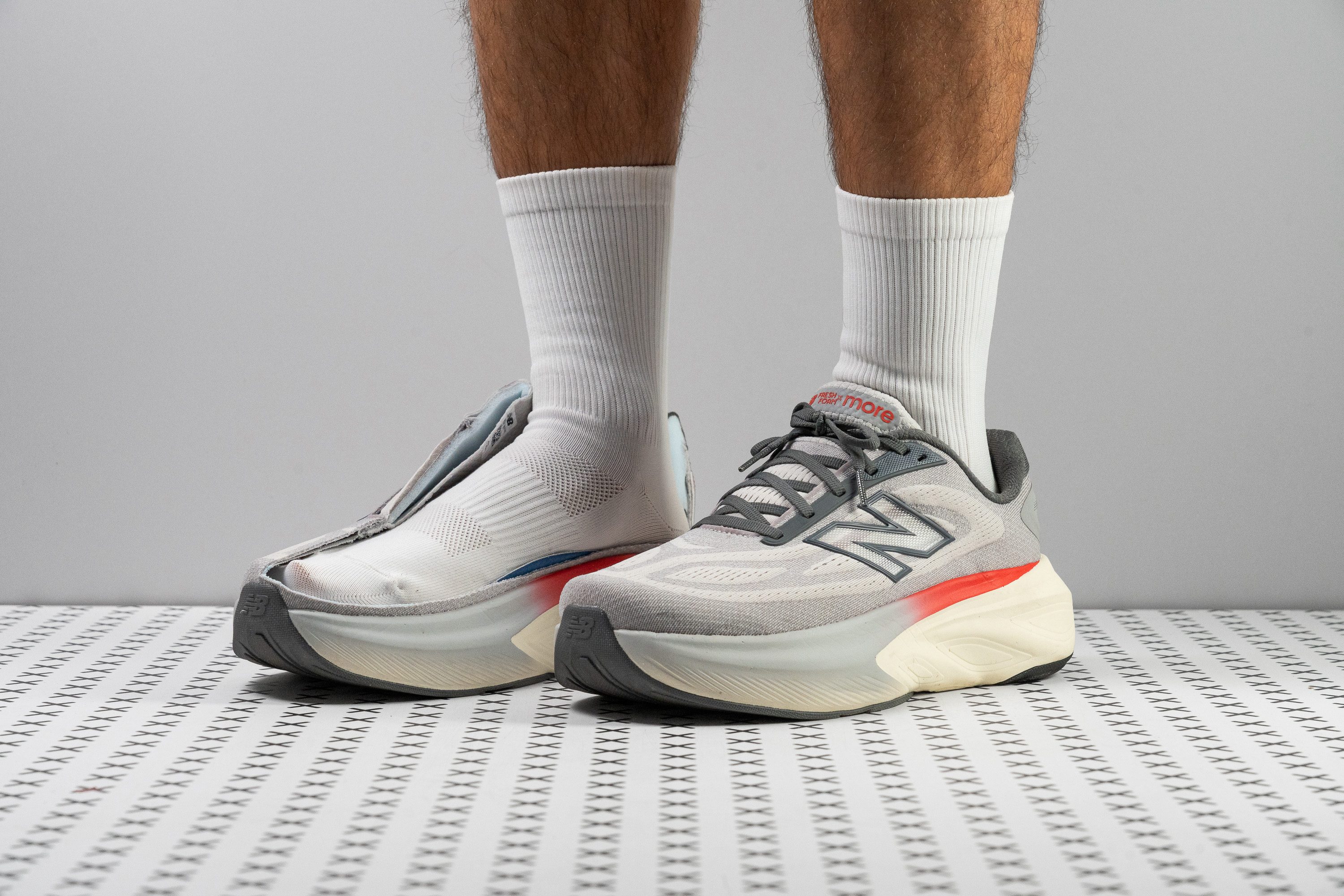













































What makes it the best?
The Fresh Foam X More v6 truly embodies “More” with its plump midsole delivering maximum comfort. Its staggering height and protective cushion lead in shock absorption among New Balance running shoes with its gentle yet stable ride. Its durable outsole further enhances its performance in our lab tests.
More v6 delivers an ethereal sensation that makes our runs enjoyable and therapeutic, shining best in relaxed paces. Our precise measurements cement its domination in cushioning, placing it among the tallest and softest we’ve seen in the lab. Its stack is a massive 41.8/38.5 mm, the forefoot being a solid 12.5 mm above average. Meanwhile, its shock absorption rates of 152 SA (heel) and 144 SA (forefoot) are off the charts, with the front being 37.1% higher than usual. These numbers show there’s no room for doubt in terms of comfort.
While a super stacked shoe means less stability, More v6 surprises us with well-planted strides. The substantial landing platform is the key ingredient. At 122.5/102.0 mm, it’s one of the widest we’ve seen in the lab! For reference, the average is only 114.3/90.8 mm.
The supportive outsole features rubber coverage in high-impact areas. With only 0.8 mm damage in our Dremel test, it proves to be reliably protective since it showed 20.0% less wear compared to the average.
However, the toecap feels overly tapered and may be restrictive for wide or swollen feet. Those who prefer more toebox volume should check the wide and extra-wide options, or maybe another pair.
Pros
- Record-breaking shock absorption
- Wide platform ensures stability
- Super-plush foam
- Improved energy return
- Cosy upper
- No price hike this year
- Ideal for forefoot strikers
- Solid durability
- Semi-gusseted tongue for secure lockdown
- Good torsional flexibility despite its size
Cons
- Narrow, low-volume interior fit
- Still a heavy shoe
- Weak airflow
- Low drop doesn't work for everyone
Best budget New Balance running shoes
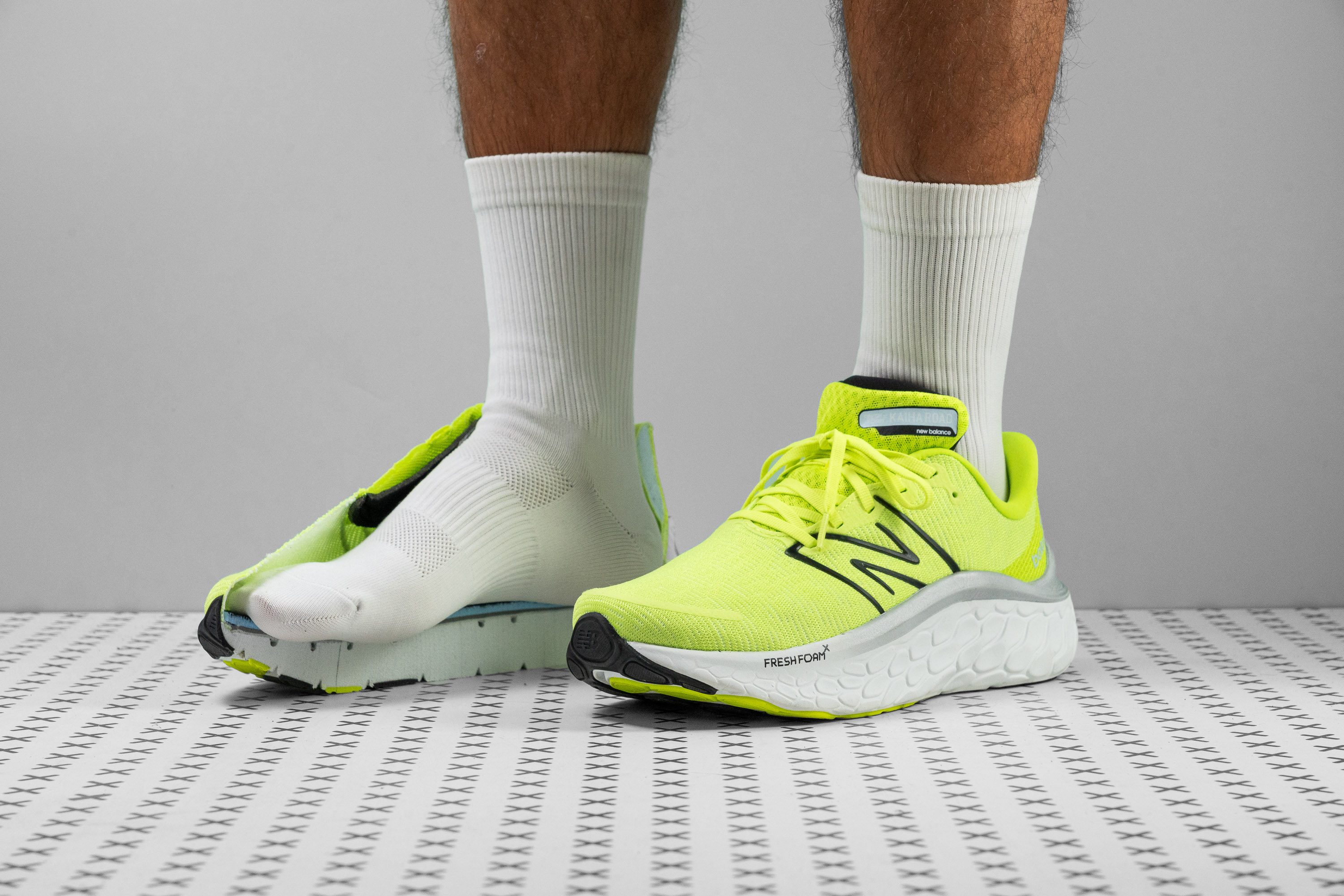











































What makes it the best?
With the surprising appearance of Fresh Foam in an £90 shoe, the Fresh Foam X Kaiha Road is packed with comfort and impact protection. Coupled with a stable and grippy base, it gives us confident footing in our runs. Given that it’s 42.9% cheaper than the average New Balance running shoe we tested in the lab, it’s easily our best budget pick.
Easy on the wallet and on the feet, Kaiha Road delivers gentle landings with its cushioned nature. Our measurements recorded a solid height of 35.8/32.0 mm, the forefoot being notably taller than the 26.1 mm average. Moreover, the foam itself reduces ground impact, generating high shock absorption scores of 132 SA in the heel and 124 SA in the forefoot.
We completed each stride with a steady stance, courtesy of Kaiha Road’s broad 119.2/100.1 mm base. It leaves zero room for wobbles, especially with its maximum 5/5 torsional rigidity rating in our manual assessment.
During our runs, the outsole delivered all-weather traction, keeping us secure on dry roads or wet pavements. In our wet-condition test, we verified its dependable grip of 0.53.
Note that Kaiha Road features a minimal 3.8 mm drop, making it more suitable for midfoot and forefoot strikers. We recommend heel strikers to go for pairs with a steeper drop.
Pros
- Marshmallowy plush cushioning
- Great for recovery days
- Extremely flexible and forgiving
- Rockered midsole for smooth transitions
- Above average breathability
- Excellent performance in cold conditions
- Provides good stability
- Ideal for long runs
- Accommodating toebox
Cons
- Lacking in upper durability
- Needs some breaking in
- Needs some breaking in
Best New Balance running shoes for tempo workouts
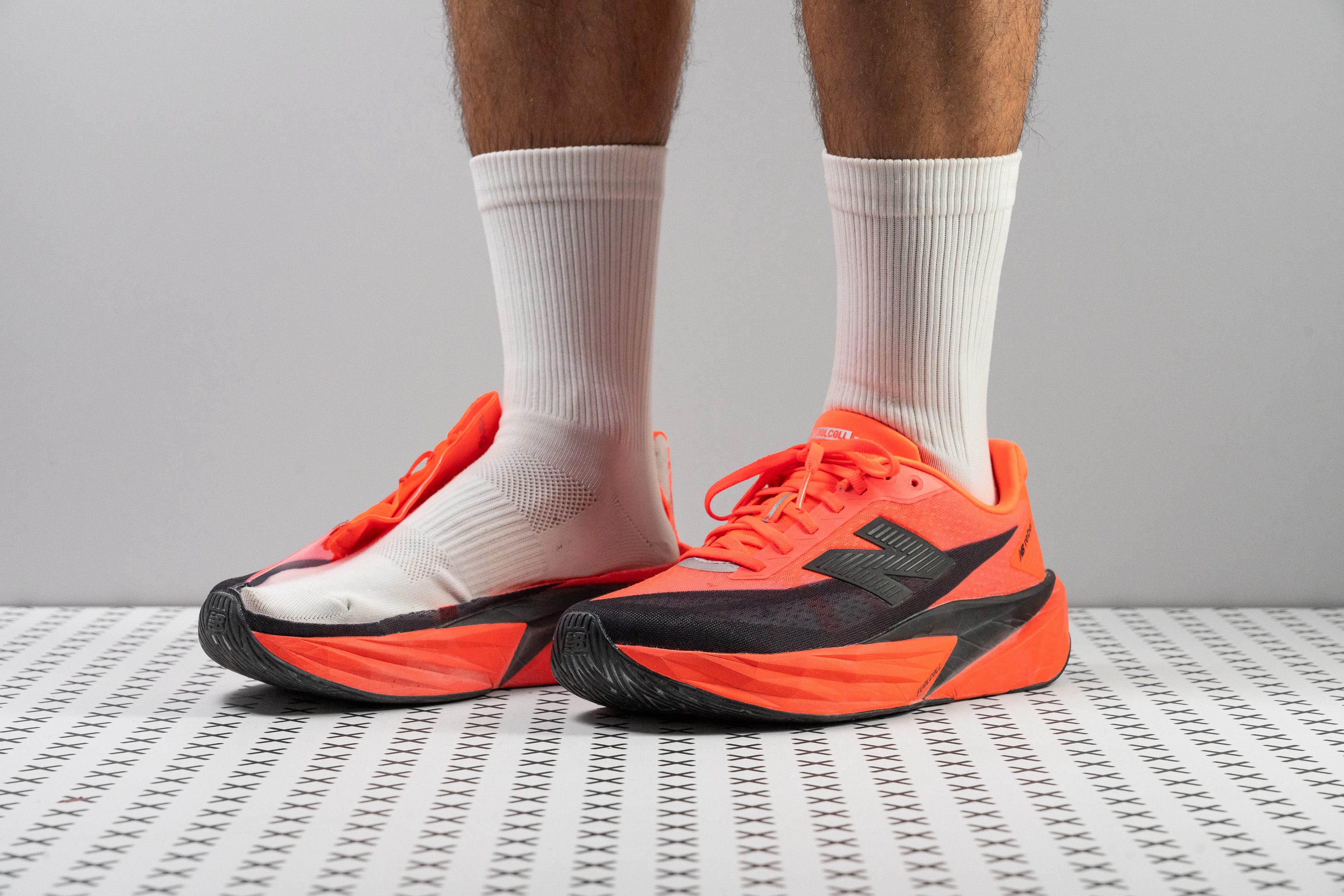











































What makes it the best?
Within the New Balance lineup, the FuelCell Rebel v5 shines as the ultimate choice for tempo training, and it's no surprise. Its featherlight construction, agile build, and responsive yet comfortable ride elevate every run—a fact supported by both our runs and lab analysis.
At a mere 7.8 oz (220g), the Rebel v5 is a standout, boasting a weight that's 17.0% lighter than the average road-running shoe, making it ideal for effortless intervals, fartlek sessions, and tempo runs. This trainer maintains a light build due to its moderately low stack, which enhances agility.
What also keeps us nimble is the flexible midsole that gives a natural feel, perfect for runners who want to build speed without the aid of stiff carbon plates. True enough, our bend test confirms Rebel v5 is 22.0% more adaptive than average.
The platform enchants our feet with its plushness, as our shock absorption test reveals a solid score of 145 SA in the heel. Each step feels indulgent, blending a heavenly cushioned feel with an energetic rebound that’s ideal for speed workouts. In our energy return test, Rebel v5 impressed with 59.8% in the heel and a massive 67.3% in the forefoot.
However, it's worth noting that the upper lacks a bit of ventilation for heated sessions. Those who prioritise breathability should find an alternative trainer.
Pros
- Lightweight build
- Cloud-soft FuelCell foam
- Fixes all issues from v4
- Maintains the same price from v4
- Handles easy runs and tempo sessions
- Top pick for midfoot strikers
- Still flexible and fun
- Improved fit overall
- Still flexible and fun
- Improved fit overall
Cons
- Runs warm on hot summer days
- Upper durability is a concern
- Traction could be better
Best New Balance running shoes for race
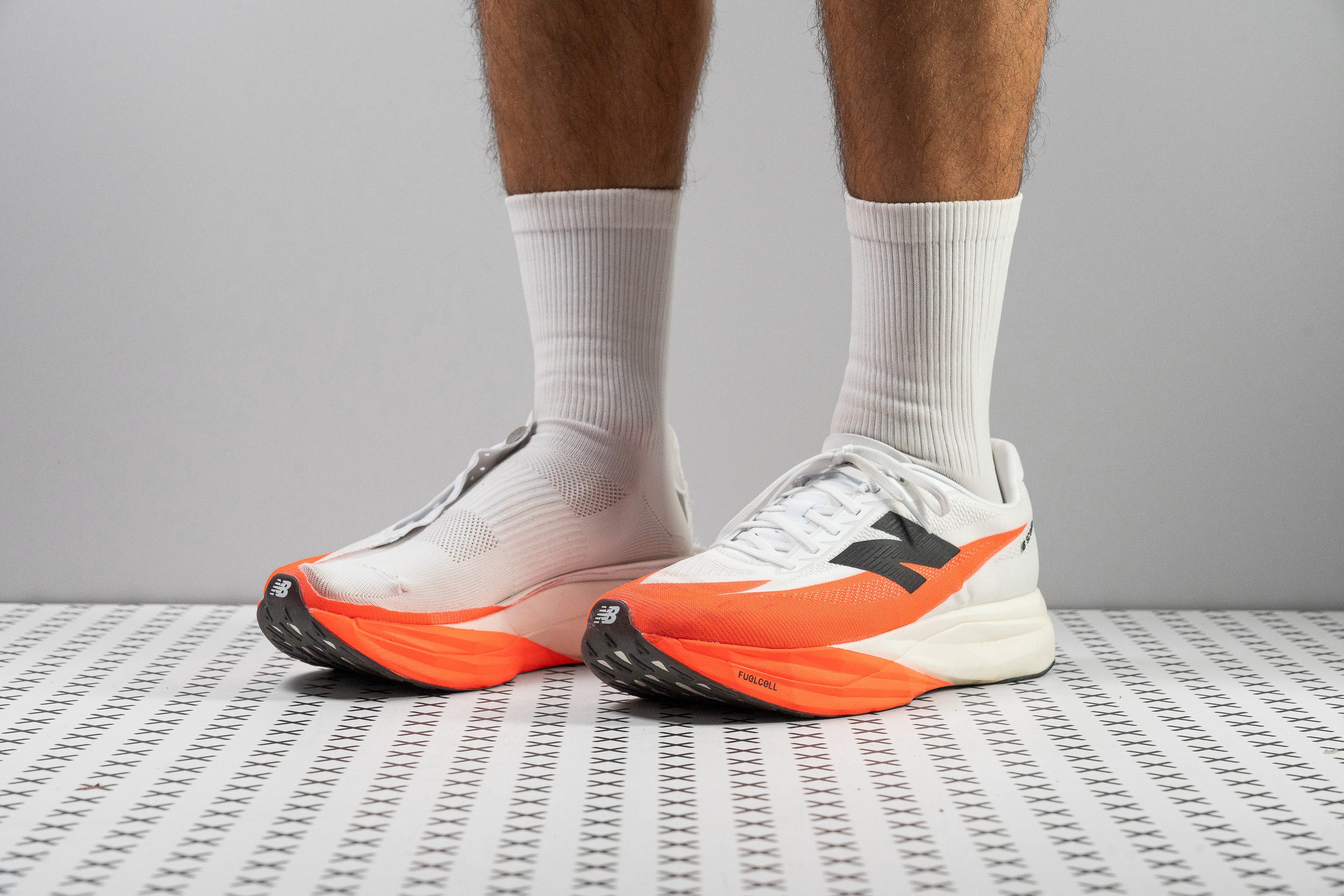
















































What makes it the best?
Among all New Balance shoes we tested, Fuelcell Supercomp Elite v5 is our top racer. With race-legal soaring stack heights, incredible responsiveness, and the Energy ARC carbon plate, it provides all the support and energy we need for hard miles. To confidently smash long distances and fast paces, the ultra-plush ride and grippy outsole support our strides.
An elite in terms of cushioning, it rises to 39.3 mm in the heel, nearing the legal limit to maximise both cushioning and energy return. Our feet are spoiled with pillowy goodness, earning a solid shock absorption score of 144 SA and recording high levels of energy with each stride. The heel scored 74.8% and the forefoot an incredible 74.9%. This superior combination saves our legs from repetitive impact and fatigue.
To enhance speed, it features New Balance’s Energy ARC design, which incorporates a curved plate and a void underfoot for enhanced ease of movement. The plate’s shape is more aggressive than the previous version, leading to a snappier sensation underfoot.
The outsole features a very tacky rubber, which scored an impressive 0.61 rating in our wet condition test. With 29.8% stronger traction than average, we felt confident going all out regardless of weather conditions.
However, its slim build sacrifices stability. We can only recommend this racer to runners with consistently precise and proper form.
Pros
- Improved performance and speed
- Roomy toebox (for a competition shoe)
- Maxed-out heel stack
- Much lighter than before
- Strong grip from new outsole design
- Redesigned plate curvature for faster transitions
- Premium, breathable upper
- Fixes heel and tongue issues from v4
Cons
- Still not among the fastest supershoes
- Narrow heel reduces stability
- High drop may not suit everyone
- Comes without high-grip laces
Best New Balance stability running shoes



























































What makes it the best?
Crafted with comfort and unobtrusive support in mind, the Fresh Foam X 860 v14 offers plush cushioning, gentle stability, and a flexible ride, solidifying its status as our top New Balance stability shoe in the lab. We took each stride confidently in our runs without the rigidity typically associated with stability shoes.
The shoe ensures unmatched steadiness through its dual-density midsole foam and unique EVA plate. Our durometer shows the main layer is a plush 10.9 HA for comfort while the heel has a small and firmer 23.8 HA for stability.
Sandwiched in between is an EVA film plate that improves our balance without adding too much stiffness to the shoe. Our bend test confirms that 860 v14 is 28.9% more adaptive than average. Even as we tested its torsional rigidity, it emerged more flexible than average with a 3/5 rating.
Besides its fluid ride, the shoe feels luxurious thanks to its generous stack—another unusual feature of stability shoes. Our calliper shows it’s 36.8/27.5 mm vs. the 34.0/25.4 mm average road running shoe, erasing any harshness underneath regardless of foot strike and distance.
However, the shoe’s performance in our Dremel tests is underwhelming, which means it’s not the most durable shoe. Those who want a long-lasting pair should check alternatives.
Pros
- Innovative, dual-layer midsole
- Great for short and mid-distance runs
- Ideal for heel strikers
- Comfortable for casual use
- Good value
- Reliable for daily mileage
- Great outsole coverage
- Superb lockdown
- Reflective elements
Cons
- Limited breathability
- Upper lacks durability
- Could be lighter
New Balance running shoes with the best energy return
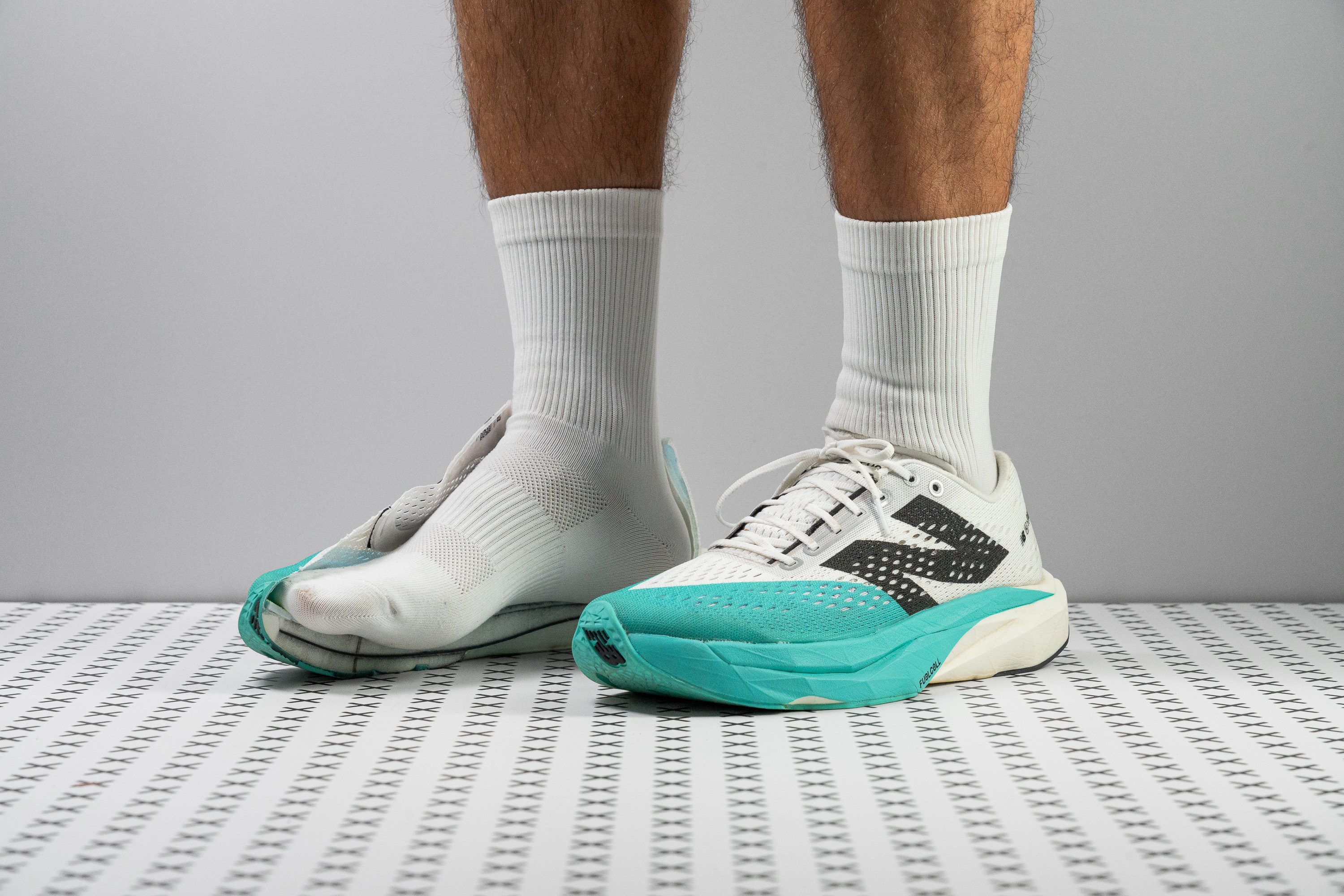




















































What makes it the best?
The New Balance FuelCell SuperComp Pacer v2 delivers an explosive ride in our runs, and our lab tests confirm it offers the best energy return among New Balance running shoes. Even with its moderate stack, it is impressively responsive and cushioned enough to keep our legs feeling fresh. Combined with its light build and airy upper, it delivers a smooth, soothing experience mile after mile.
We were eager to test the FuelCell midsole in terms of energy return, and it did not disappoint with 75.2% in the heel and 75.8% in the forefoot. The shoe feels far from dull, while its minimal 7.1 oz (200g) build further boosts our speed and agility.
SuperComp Pacer v2 is reminiscent of an old-school racer with its moderate stack, measuring 32.9/25.4 mm. It offers good ground connection without feeling harsh on our joints. We recorded near-average shock absorption scores of 132/97 SA, proving its comfort.
The upper wraps our feet in a cool embrace. It’s dotted with large ventilation holes, which allow seamless airflow. In our smoke test, it achieved the maximum 5/5 breathability score. However, it surrendered immediately in our Dremel test, earning the lowest 1/5 durability score. If this is a dealbreaker, we recommend going for a pair with sturdier construction.
Pros
- Diseñadas para volar en carreras de 5K/10K y medio maratón
- Ideales para corredores ligeros
- Más baratas que la mayoría de las superzapatillas
- Upper muy transpirable
- Destacan en entrenamientos de intervalos
- Han mejorado en comparación con sus predecesoras
- Perfectas para los amantes de las clásicas voladoras
- Espuma PEBA mullida y con rebote
Cons
- Teniendo en cuenta la altura de su suela, deberían ser más ligeras
- Puede que te rocen en el tendón de Aquiles
- Talón inestable
- Lengüeta corta y sin refuerzo
New Balance models and their main purpose
New Balance releases shoes under different numbers and names. Here’s an overview for easier navigation.
|
Model |
Terrain |
Arch support |
Best use |
Must know |
|
Road-to-trail |
Neutral |
Light trails |
Good for beginners |
|
|
Road |
Neutral |
Daily run |
Outstanding value, entry-level |
|
|
Road |
Stability |
Daily runs, long runs |
||
|
880 |
Road |
Neutral |
Daily runs, walking |
Insanely comfortable |
|
Road |
Neutral |
Daily runs, long runs |
Supreme softness |
|
|
1440 |
Road |
Neutral |
Daily runs |
Plastic heel clip |
|
Road |
Neutral |
Daily runs, recovery runs |
Bang for the buck |
|
|
Balos |
Road |
Neutral |
Daily runs |
|
|
Cruz |
Road |
Neutral |
Daily runs |
|
|
Trail |
Neutral |
From light trails to moderate and technical; Hiking |
Great for cold weather |
|
|
Road |
Neutral |
Daily and recovery runs |
Marshmallowy but not responsive |
|
|
Road |
Neutral |
Daily, recovery runs, walks |
Great for mileage |
|
|
Trail |
Neutral |
Light to moderate trails |
Protective without a plate |
|
|
Trail, road-to-trail |
Neutral |
Moderate and light trails |
Budget-friendly and versatile |
|
|
Road |
Neutral |
Daily runs, speedwork |
Flexible TPU plate, very durable outsole |
|
|
Road |
Neutral |
Daily runs, speedwork |
Flexible, fun, stable ride |
|
|
Road |
Neutral |
Speedwork and racing |
Marathon-ready, leg-saving, carbon-plated |
|
|
SuperComp Pacer |
Road |
Neutral |
Racing |
|
|
Road |
Neutral |
Speedwork, long runs |
Plush, rockered, available in Wide, carbon-plated |
|
|
Trail or road-to-trail |
Neutral |
Light trails |
Great for beginners |
|
|
Road |
Stability |
Daily runs, long runs |
Mild stability but heavy. v6 got a Seal of Acceptance from the American Podiatric Medical Association |

New Balance foams explained
New Balance Fresh Foam and Fresh Foam X
This is an EVA-based foam that offers enhanced, soft cushioning. In Balos, it’s a mix of 20% PEBA and 80% EVA. When we tested the softness of the More v4, we realised it’s among the 15% softest shoes that passed through our lab.
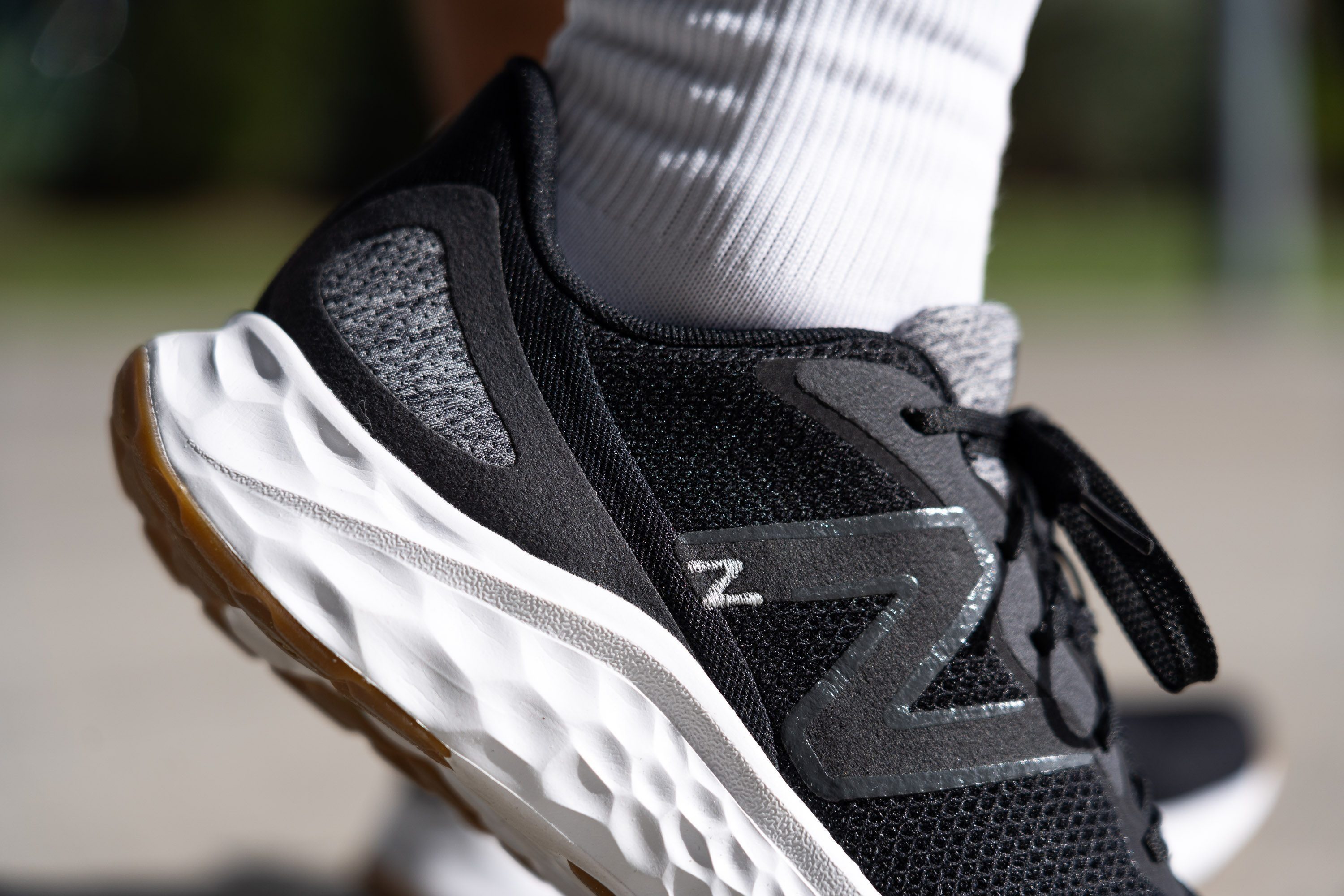
New Balance FuelCell (since 2024)
The 2024 FuelCell version is New Balance’s plush PEBA/PEBA+EVA foam with an insane energy return. You can find this upgraded foam in the SuperCompElite v4, however, in the Rebel v4, it’s a mix of PEBA and EVA and it’s also called FuelCell.
New Balance FuelCell (before 2024)
For the period 2019-2023, New Balance used a nitrogen-infused blend of TPU and EVA. This FuelCell offers less energy return than the elite foams.
It also firms up significantly in cold weather, as our lab freezer tests have shown.
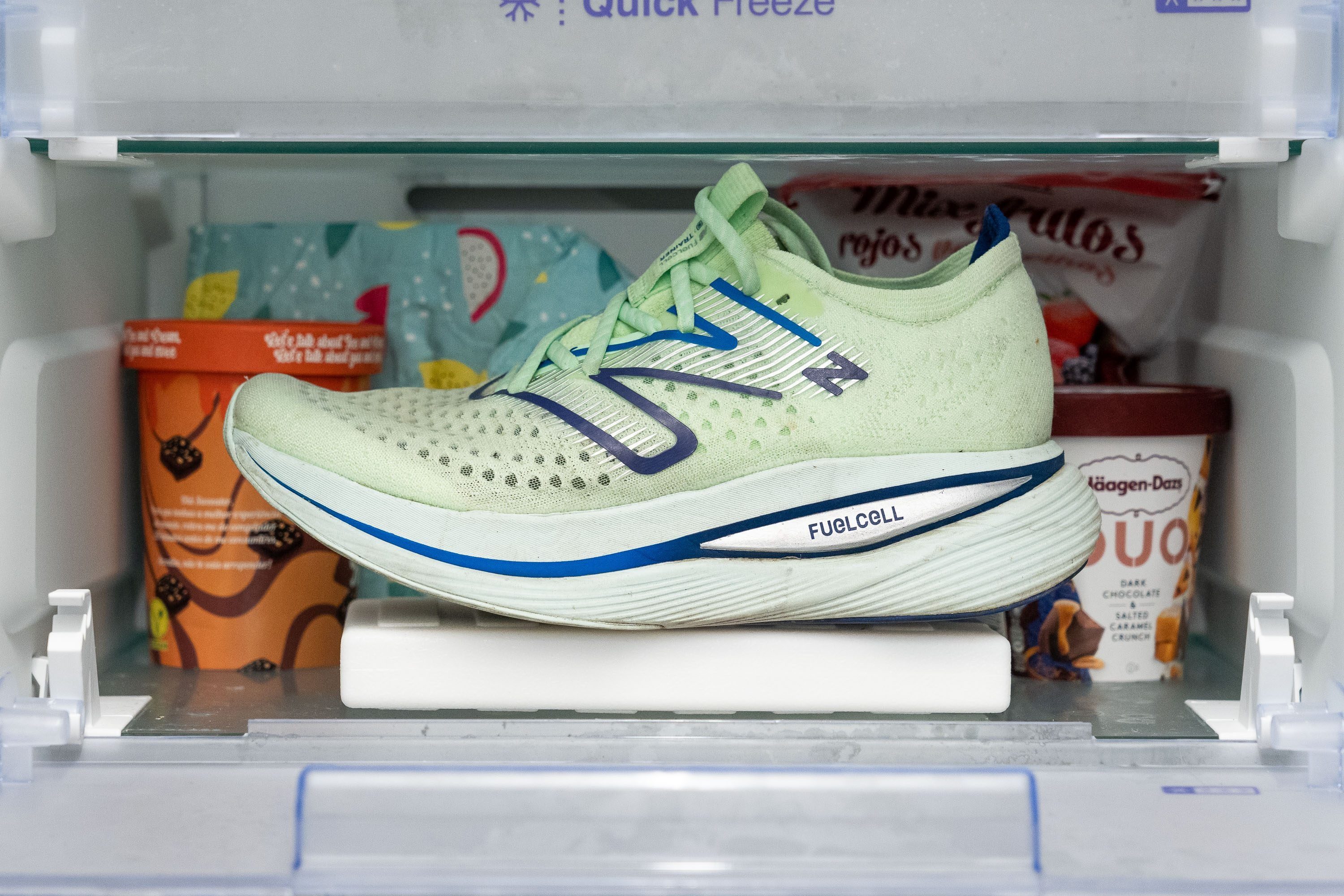
However, you should know that New Balance alters the FuelCell formulation from one model to another, which means even though the shoes are branded as FuelCell, their ride can have significant differences.
|
Foam |
Foam type |
Main advantage |
Main drawback |
Our pick |
|
FuelCell (Pebax) |
Premium |
Softness |
Weight |
|
|
FuelCell (TPU / EVA) |
Standard |
Cloud-like feel |
Stability |
|
|
Fresh Foam / Fresh Foam X (EVA / EVA + PEBA) |
Standard |
Softness |
Mushy |
If you are not familiar with PEBA yet, it stands for polyether block amide. It’s responsive and snappy but not durable, and it's usually reserved for race shoes.
TPU (thermoplastic polyurethane) is comfy, durable, and heavy. It became popular thanks to Adidas Ultraboost daily trainers.
EVA stands for ethylene-vinyl acetate. This foam is very durable and shock-absorbing, but it is not responsive enough compared to other foams.
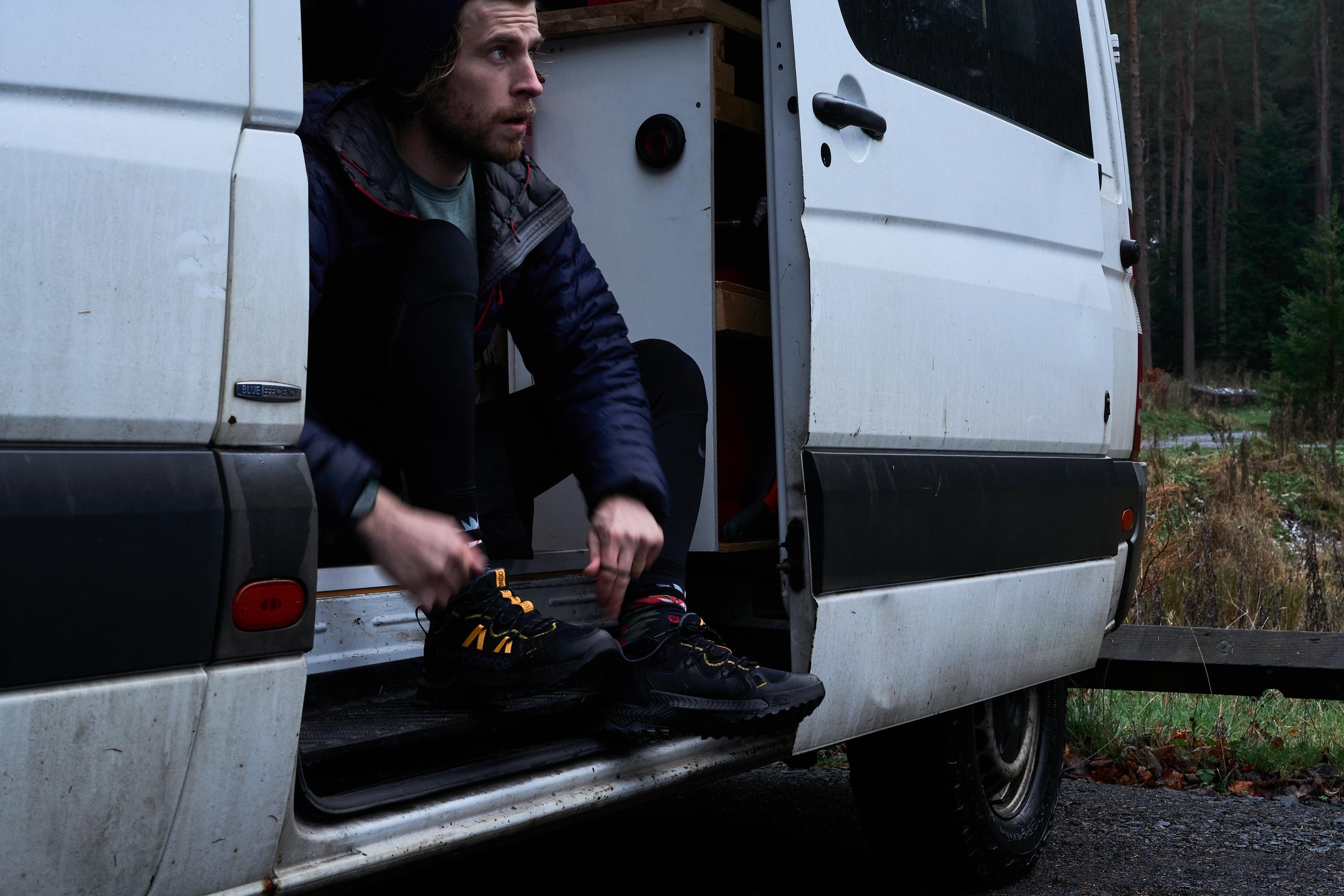
| Learn more about foams, their properties, history and combinations in our ultimate guide on running shoe foams. |
Why New Balance midsoles look the way they look
Because they use compression moulding. This process allows manufacturers to combine different foams into one midsole and to control the density and softness of EVA, TPU and PEBA. They basically preheat the material, place it into the heated mould, subject to high pressure, and wait for the material to conform to the shape of the mould as it cools and solidifies.
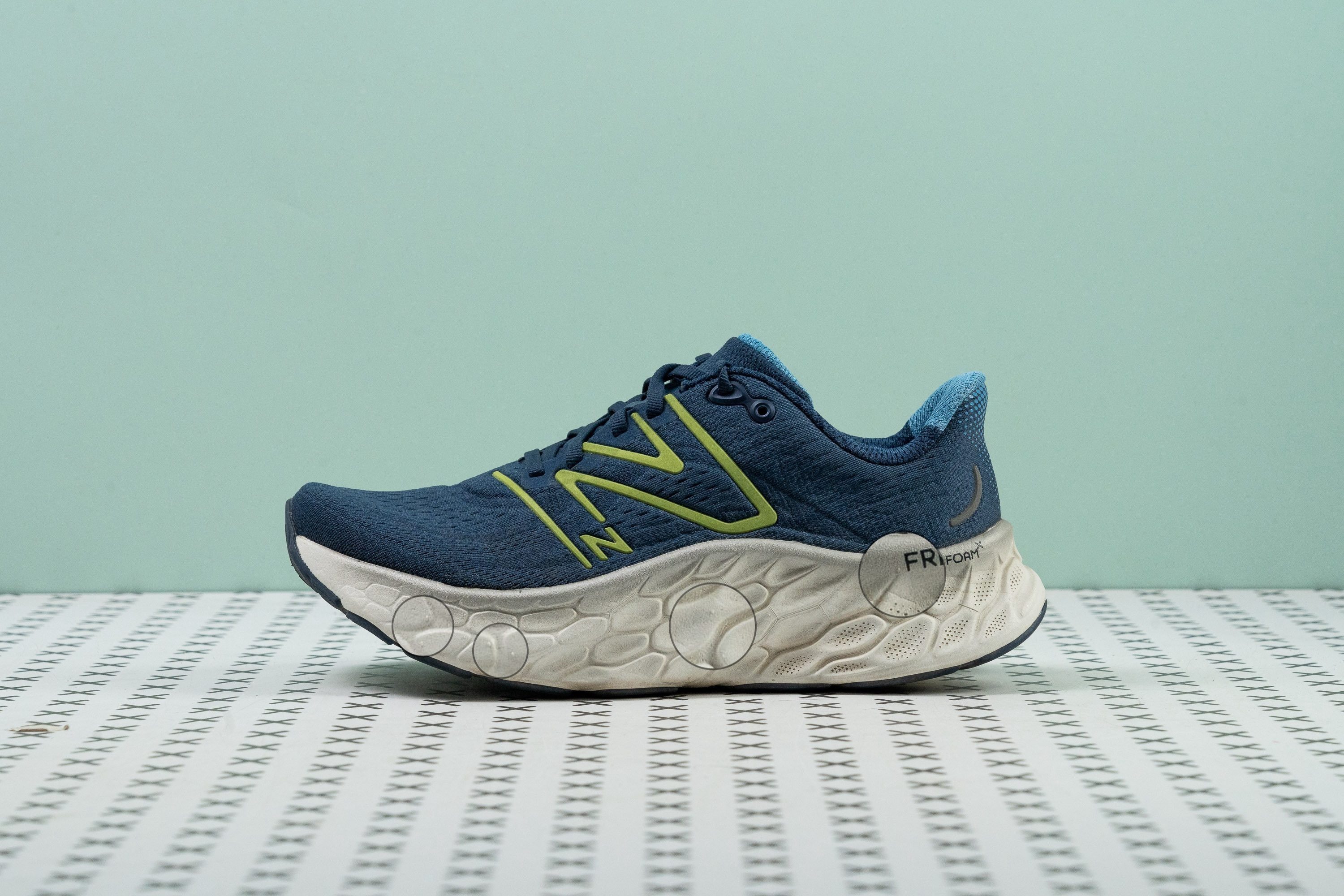
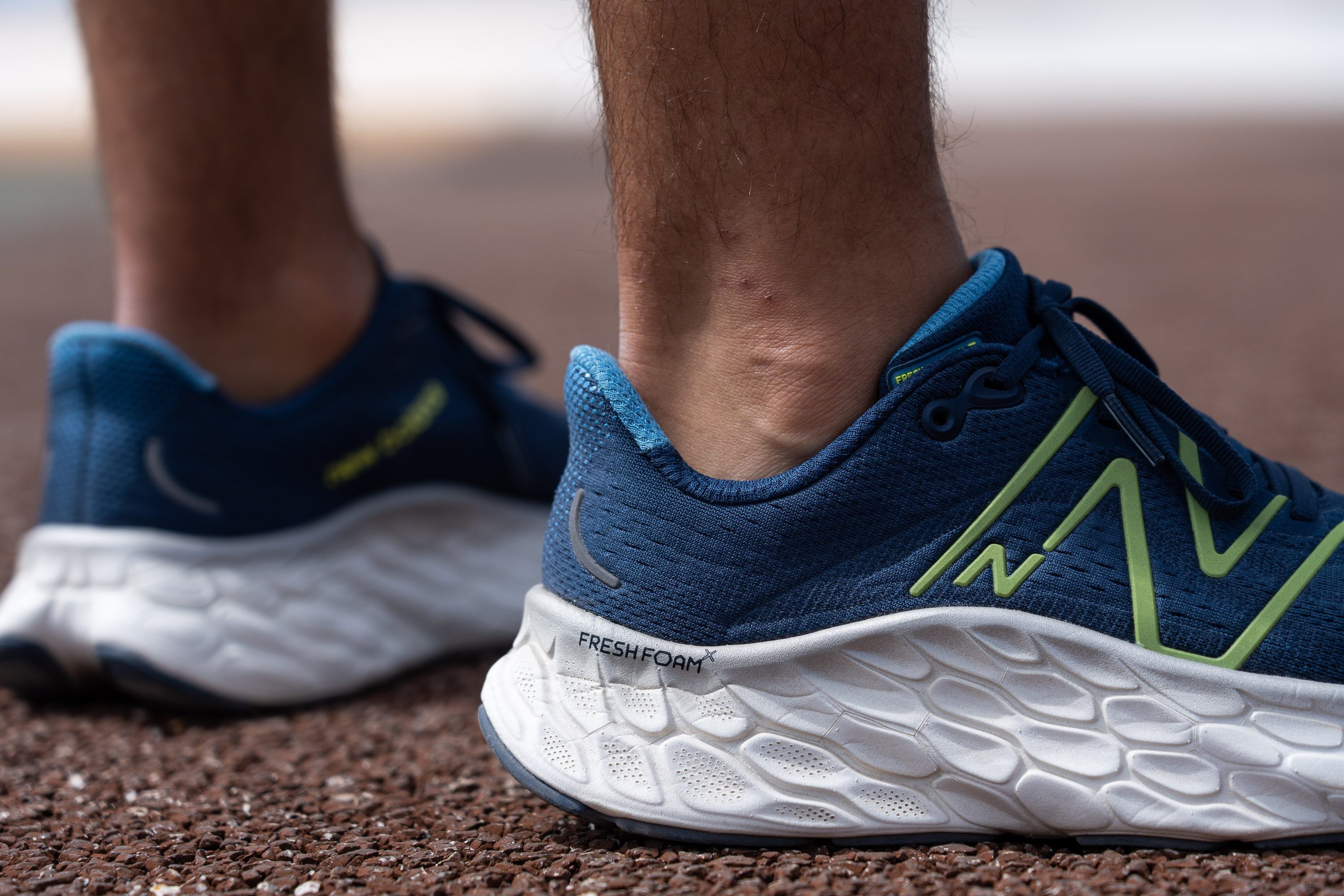
Shock absorption and energy return of New Balance running shoes
The most important features of midsoles in running shoes are their shock absorption and energy return. Fortunately, we test both. This testing allowed us to understand better the correlation (spoiler: there's no direct dependency), which we elaborated in great detail (seriously, the greatest detail) in our in-depth guides Energy return in running shoes explained and Shock absorption in running shoes: Explained and tested.
Why we need both features measured:
- shock absorption tells us how good the shoe is at reducing the impact forces that are sent towards the legs at the landing
- energy return tells us how good the shoe is at bouncing back after it was compressed at the landing
- both features combined tell us whether there will be premature fatigue due to our legs working more rather than less (if the test results are on the lower end)
Ideally, shoes should score high on both tests. However, that's obviously not the case. There are many reasons: standard foams which are usually found in daily trainers are more durable but less responsive; stability shoes can shine at stability but be significantly less responsive; beginner shoes would cost a fortune, so having around-the-average values for shock absorption and energy return in beginners' shoes is totally ok.
Traction in New Balance road running shoes
To precisely measure traction, we implemented the SATRA TM144 methodology in our lab. We use a specialised machine to test the traction of running shoes in critical conditions or, simply put, on wet surfaces. We also use a 7-degree wedge to make the shoe slightly angled.
The result of this test is a friction score, and the higher it is, the better the grip on wet surfaces (and dry surfaces as well, of course).
We also analyse the design of the outsole, focusing on the exposed midsole, rubber coverage, rubber thickness, and outsole durability.
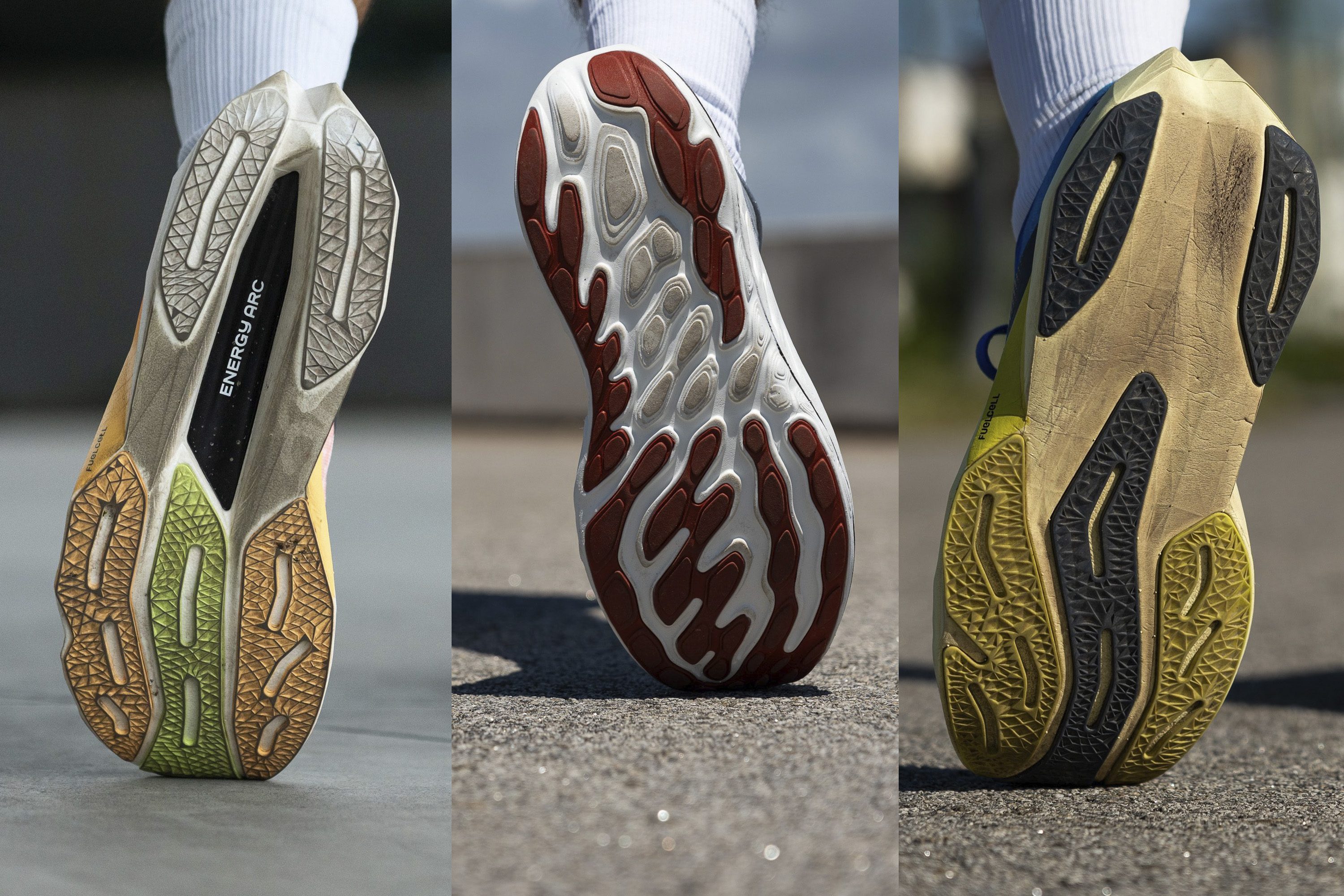
When it comes to running in wet weather, we also examine the tread pattern: best to look for a lot of channels and grooves and basically no exposed midsole (or minimal surface).
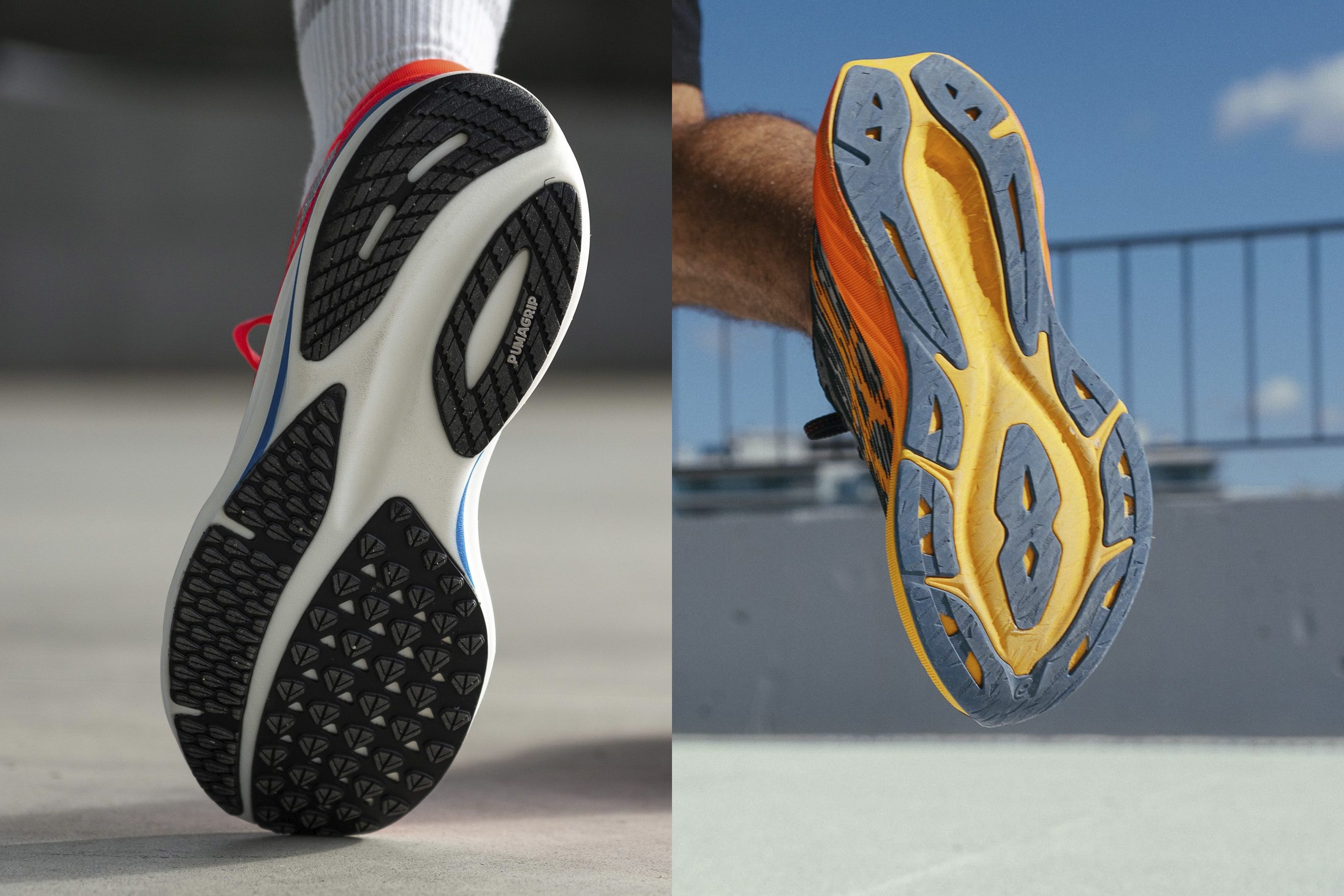
Durability of New Balance outsoles
In our lab, we measure the thickness of the outsole with a digital calliper. Thicker rubber means there’s more of it to be destroyed but also it reduces flexibility and adds weight to the shoe.
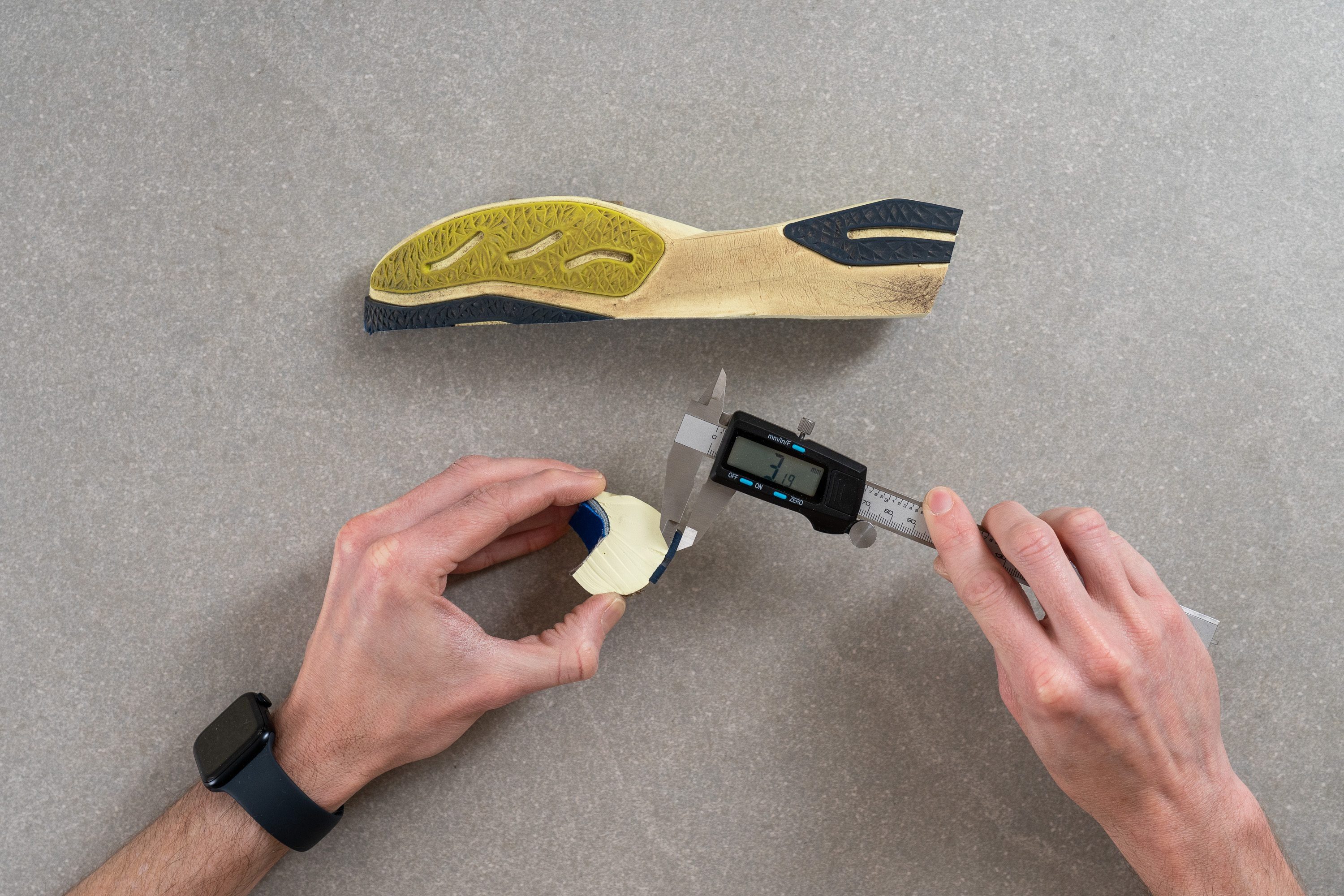
Finally, we press a Dremel against the outsole, always at the same pressure, RPMs and duration. Then, we measure the depth of the dent with a tyre tread gauge.
Deeper dents mean the outsole is less durable, while shallower dents mean it can withstand more use.
Durability and grip of trail NB shoes
It’s all about the lugs.
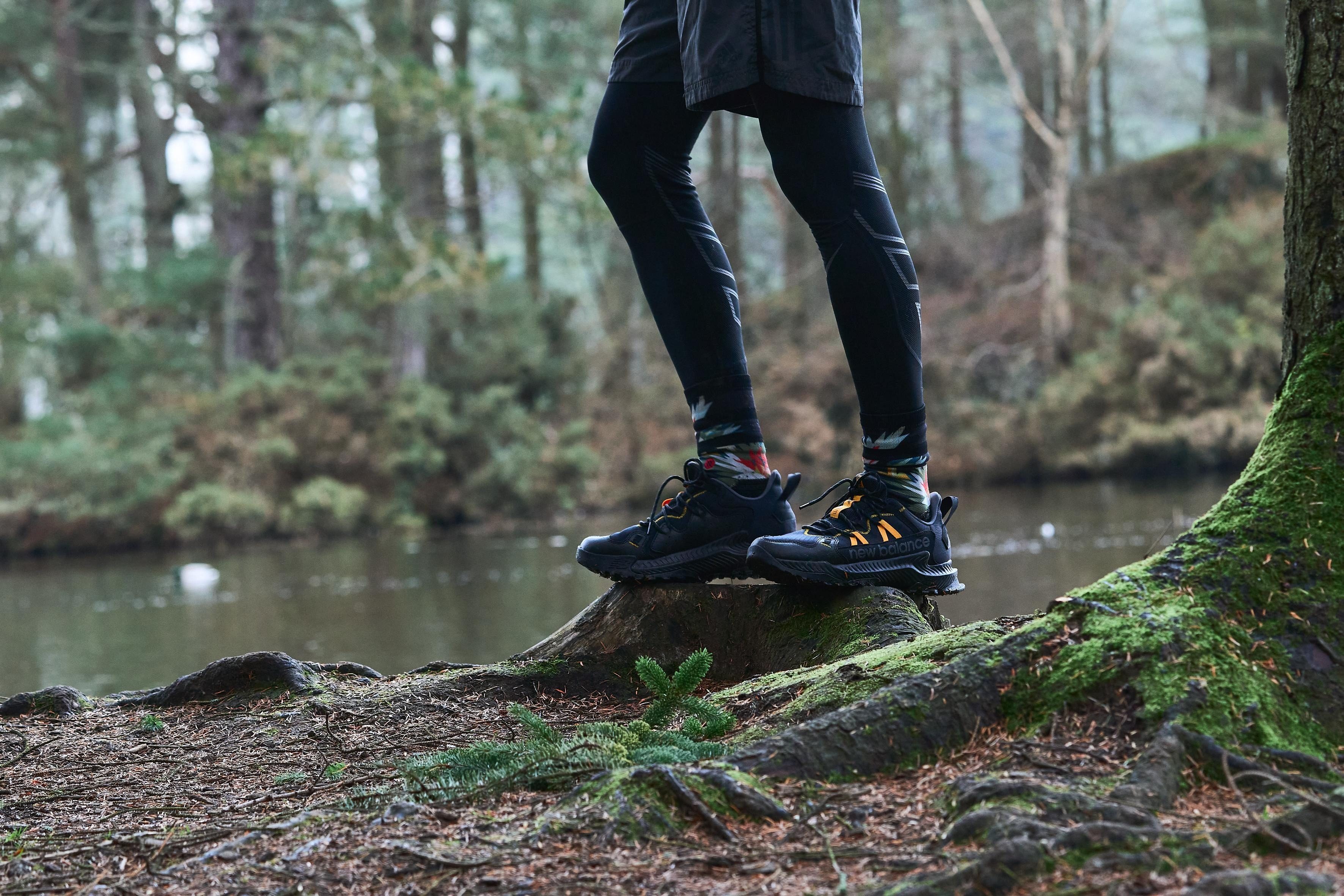
Here are our general recommendations when it comes to lug depth:
- 4mm and deeper lugs are best for slush, mud, snow. Overall, loose terrain, technical terrain
- 2-4mm is a versatile option, from hard ground to soft ground
- ~2mm or less is usually found in hybrid shoes (road to trail) because such lugs can work both on asphalt/concrete and on very light trails
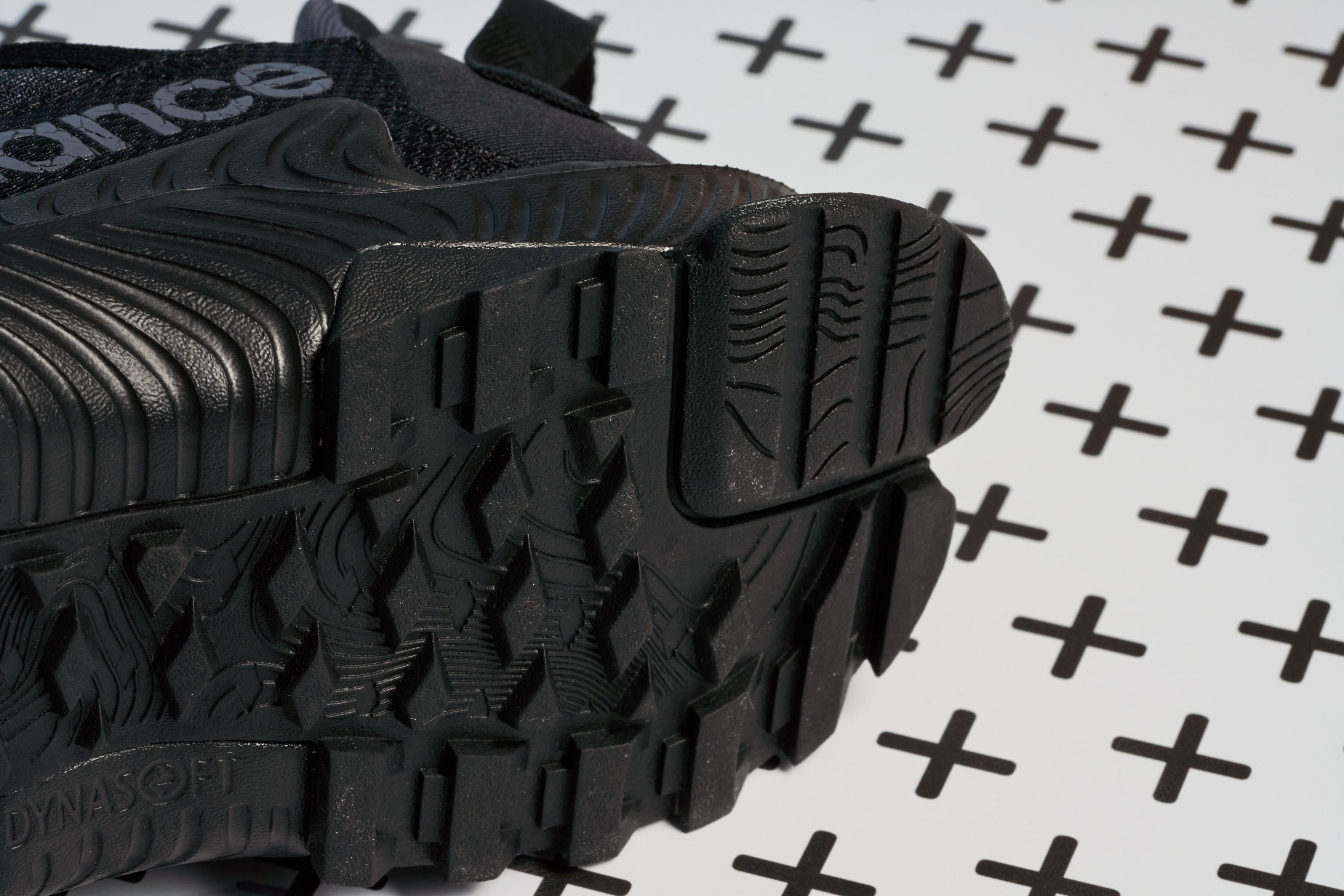
To add to this, the pattern also plays a role. Less deep lugs with more space apart works great in mud. Terrain that varies a lot (technical terrain, sand, ups and downs) asks for multidirectional grip which means differently oriented lugs. Lugs for smooth wet surfaces are usually flat, very close to each other, with channels in between them.
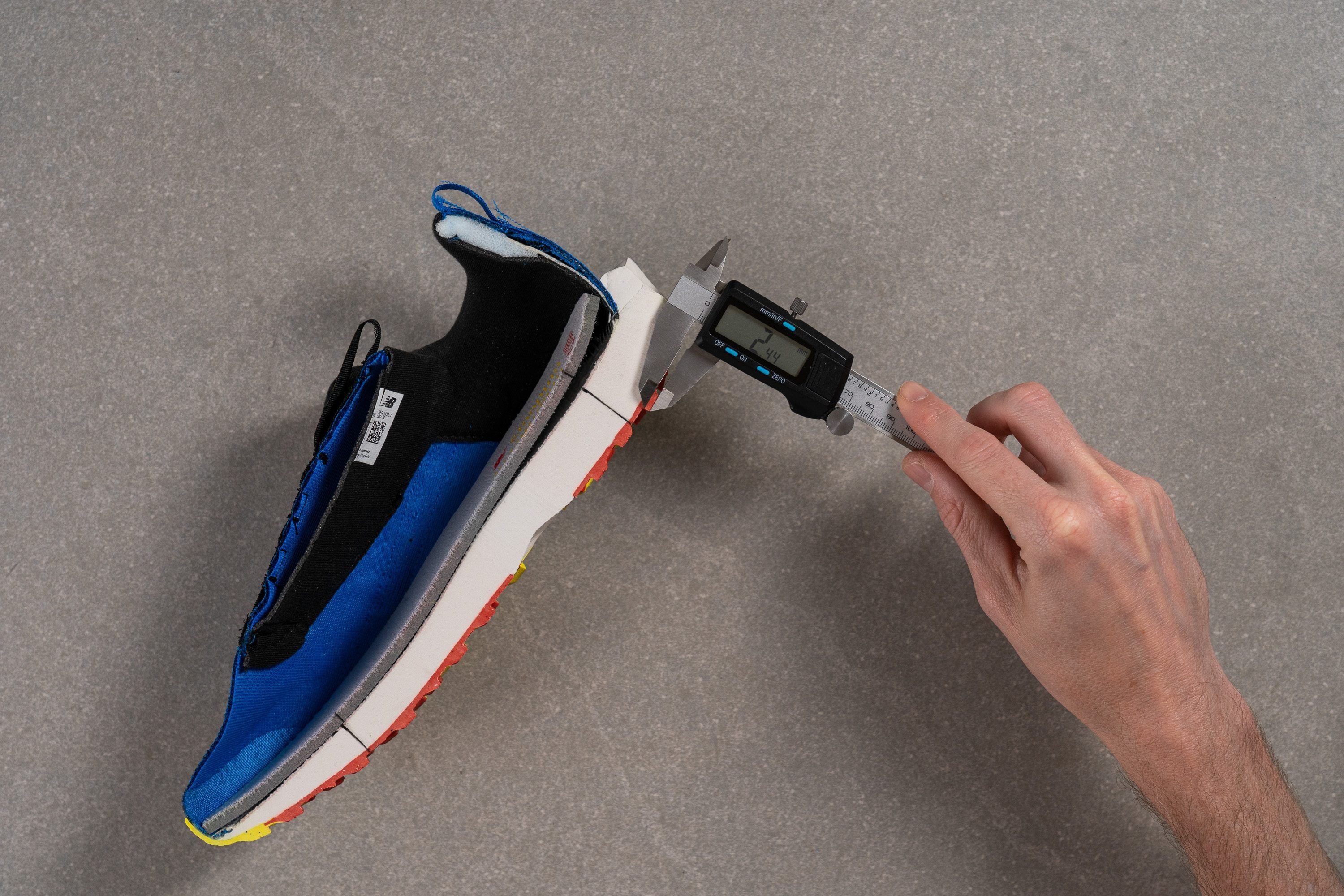
Just like with road shoes, here we also use a Dremel to test the durability of the outsole (lugs).
The deeper the dent, the less durable the lugs.

How breathable are New Balance running shoes?
Depends on the upper and on the purpose of the shoe. Let’s have a look.
For this test, we pump the smoke into the shoe and look at the smoke that comes out: when it comes out, where, and at which pace. Based on this observation, we rate the breathability of the shoe on a 1-5 scale, where 1 is the least breathable.
We do this for all shoes, road and trail. At this moment, the average breathability of New Balance road running shoes is 3.6, while the average for all road running shoes is 3.8.
Of course, we also do not stop there, but examine the uppers under the microscope, to better understand why some shoes breathe better or worse than others.
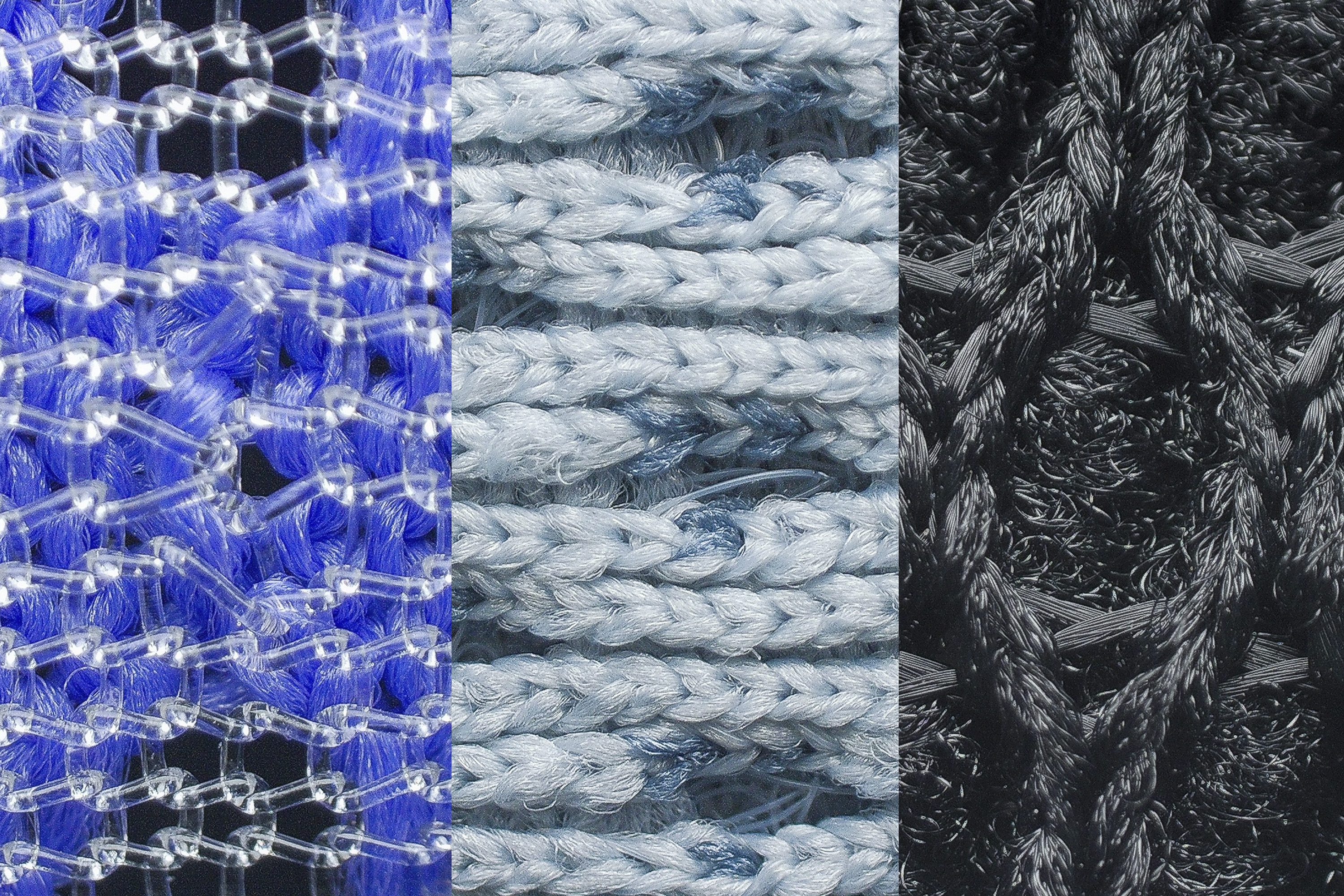
Stability (overpronation) features used in New Balance running shoes
If you overpronate, you most likely need overpronation (stability) running shoes. In the New Balance realm, there are a few models that could work for you.
When it comes to stability features, we wrote about both geometrical elements used for stability and trademarked technologies in our guide on pronation. Here, we’ll focus on stability elements in New Balance running shoes.
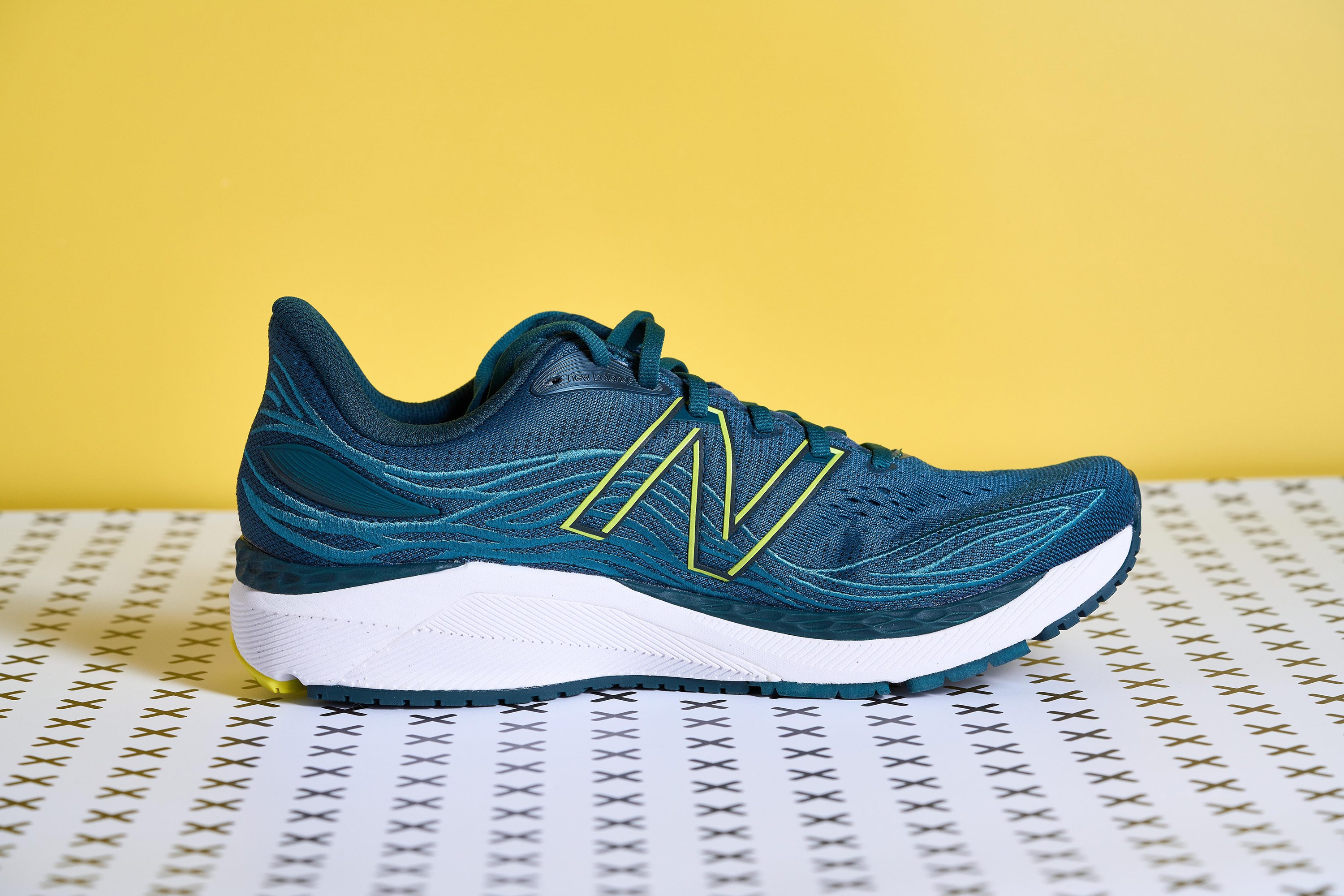
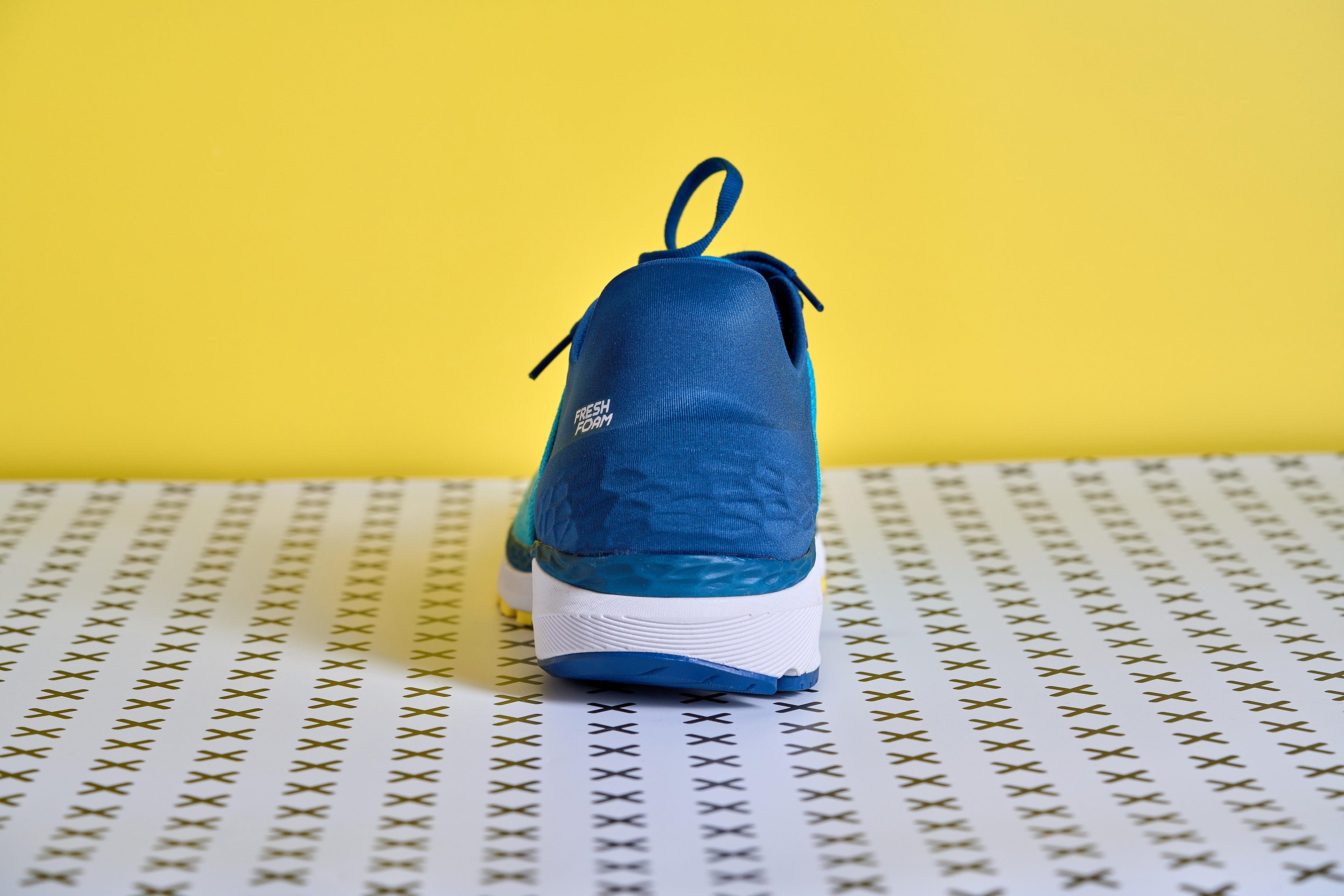
New Balance did not shy away from using the traditional medial post. It offers legitimate support below the arch in a way that it reduces the excessive rolling inward of the ankle. We can also see a bevelled heel in stability shoes from New Balance. This heel design basically imitates the shape of our heel which is rounded. This way, the heel strikes are not as harsh which means a lot for heel strikers.

New Balance also combines a dual-density midsole with an EVA plate in between. The softer foam is above, and the firmer one is closer to the ground.
Wide toebox in New Balance running shoes
The more mileage you want to log, the more comfort is needed. In short distances like sprints or very short races, it is manageable to run in shoes with a very aggressive profile and design, but that does not mean your toes should be cramped at all times. Especially not at the cost of getting black toenails, blisters, bleeding, and so on.
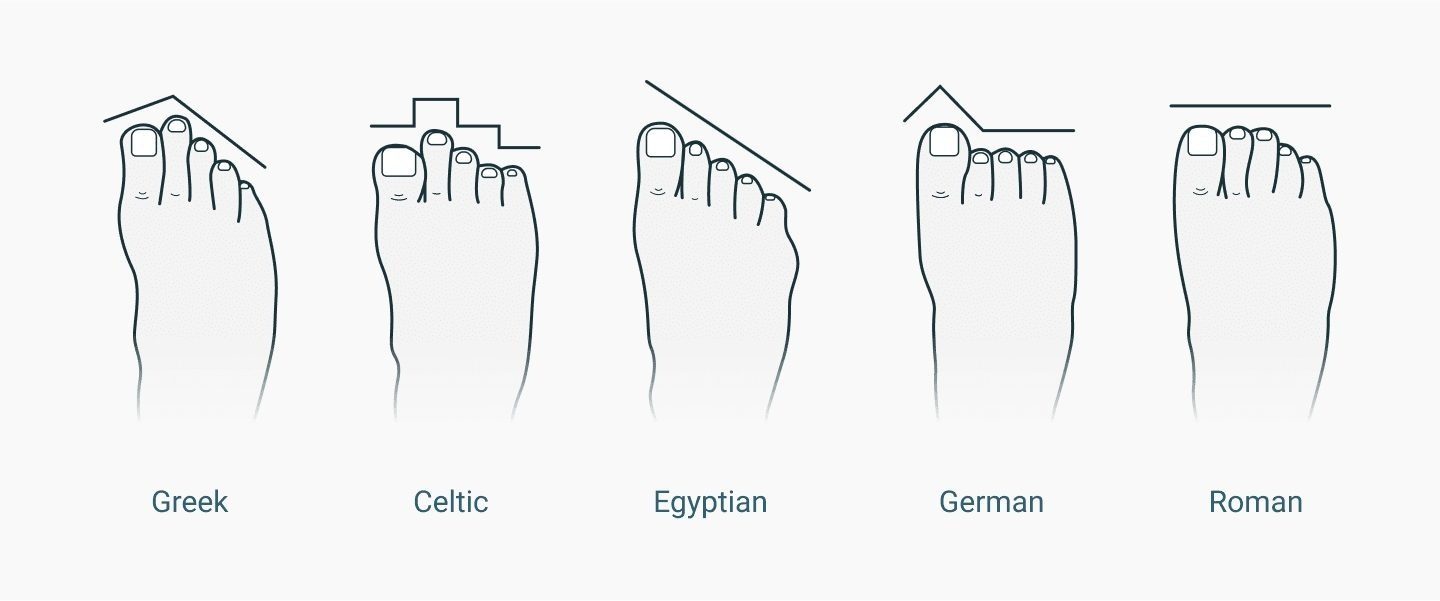
If you are looking for different widths, here’s what we do in our lab. We measure the width of the shoe in 2 places: where it’s the widest and at the big toe. This allows us to understand how much the toebox tapers or how pointy the toebox is.
Once the gel has settled, we take the mould out of the New Balance shoe and start measuring.
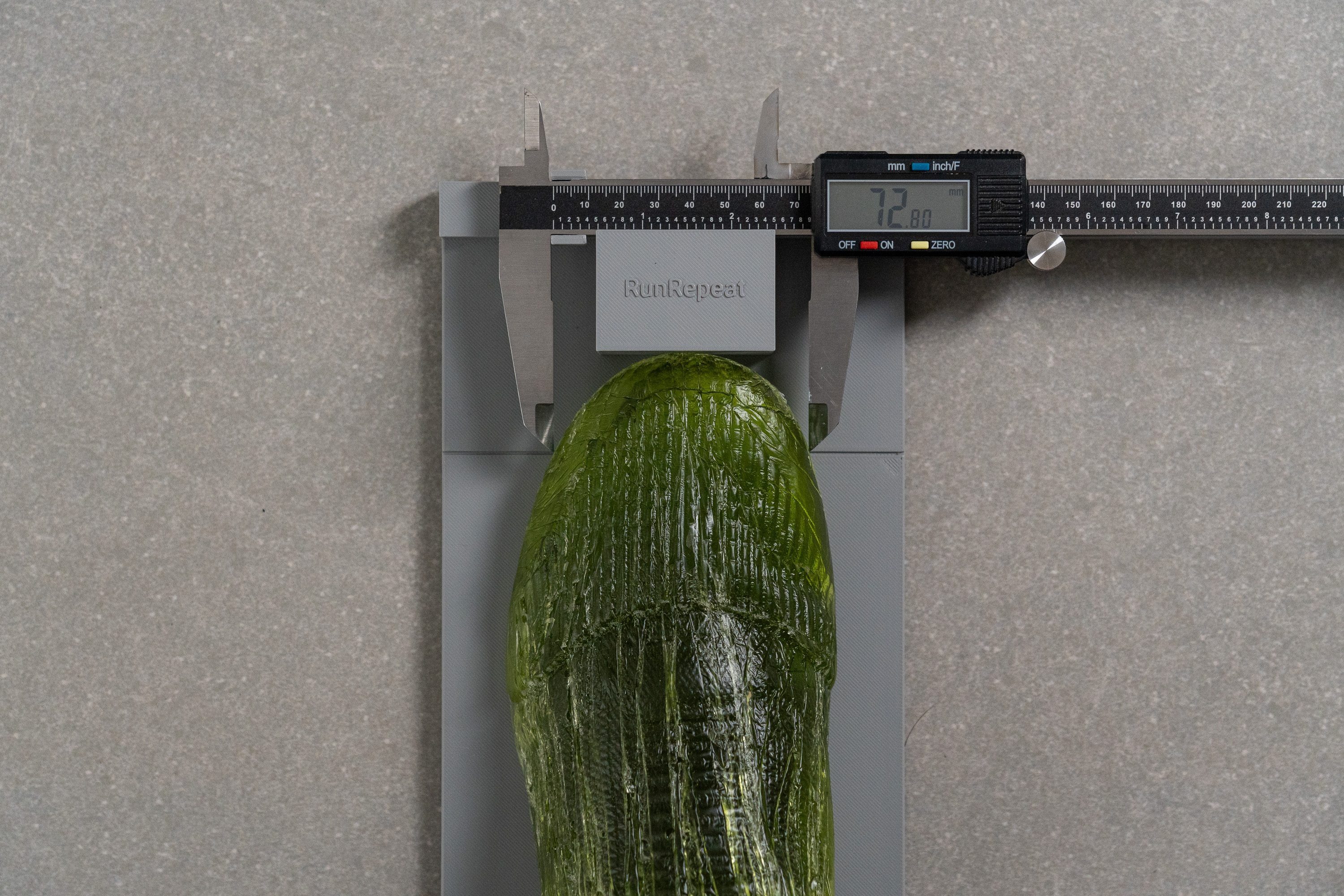
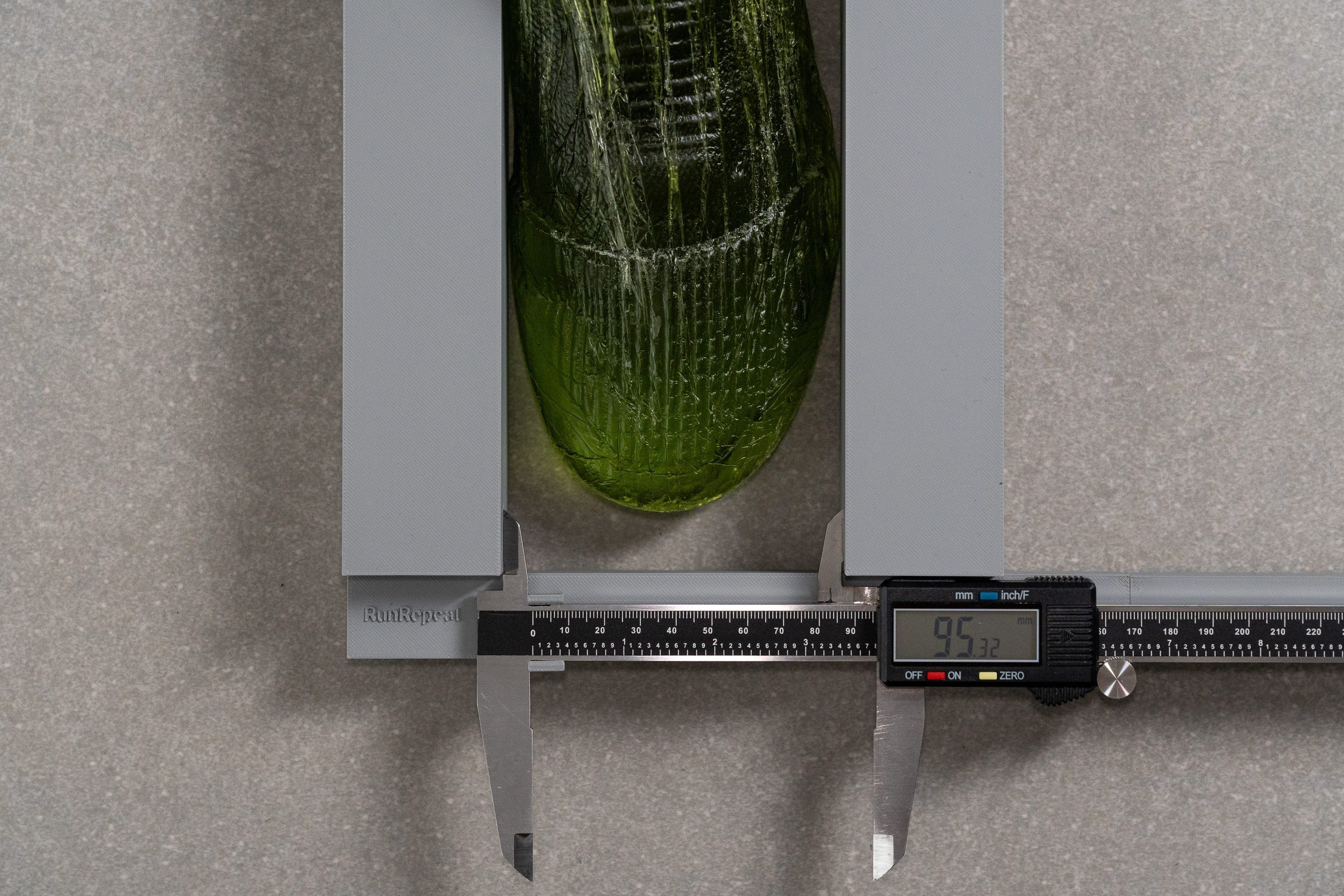

We also measure the height of the toebox in New Balance running shoes. Knowing this data can help many runners who struggle with low toeboxes and black toenails.
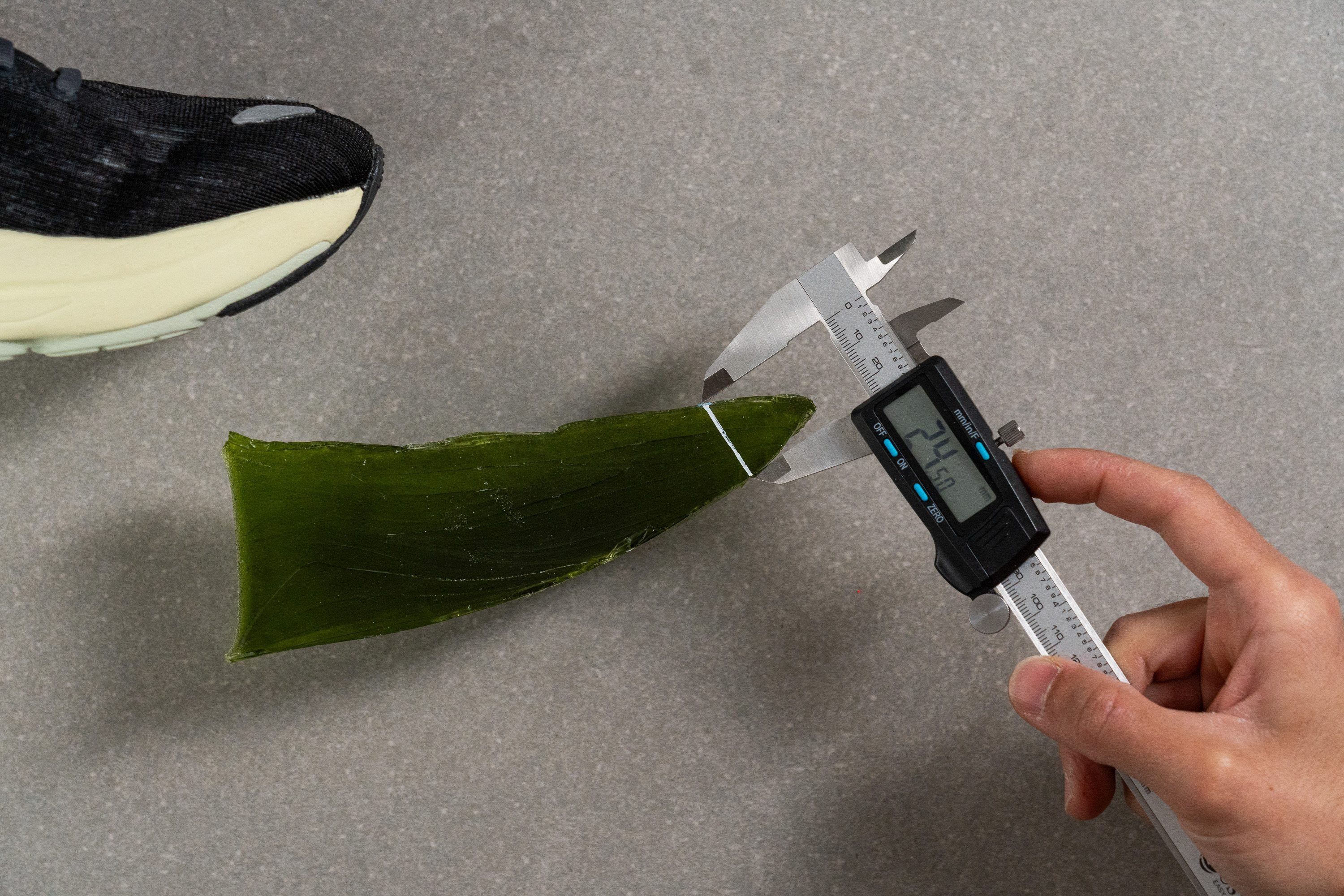
What New Balance model numbers actually mean?
The combination of letters and numbers is explained here.
The model number in the image below indicates a men’s trail shoe, model 510, colour light blue, version 6.

|
Letters at the beginning |
Meaning |
|
M |
Men |
|
W |
Women |
|
MT |
Men’s trail |
|
WT |
Women’s trail |
The most complicated numbers here are the last 2 digits because there are quite a few of them and they come with exceptions.
|
Last 2 digits of shoe style number |
Meaning |
|
40 |
Shoes that provide superior control, stability, cushioning, and support for biomechanical needs, such as pronation or low arches. Exception: 840v4 which is neutral. |
|
60 |
Stability shoes that reduce pronation while also providing cushioning and comfort. |
|
70 |
Light stability for runners who train at a faster pace. |
|
80 |
Neutral shoes for high-mileage runners. |
|
90 |
Shoes made for fast runs for speed and distance runners. Exception: 990v5 and its predecessors. |
Letters after the numbers indicate the major shoe colours. BK = black, WB = white and blue, LB = light blue, etc. The last number is the version number (e.g. v6, v15, etc). This way, M990BK5 means it’s a Men's 990 shoe, version 5, black.

